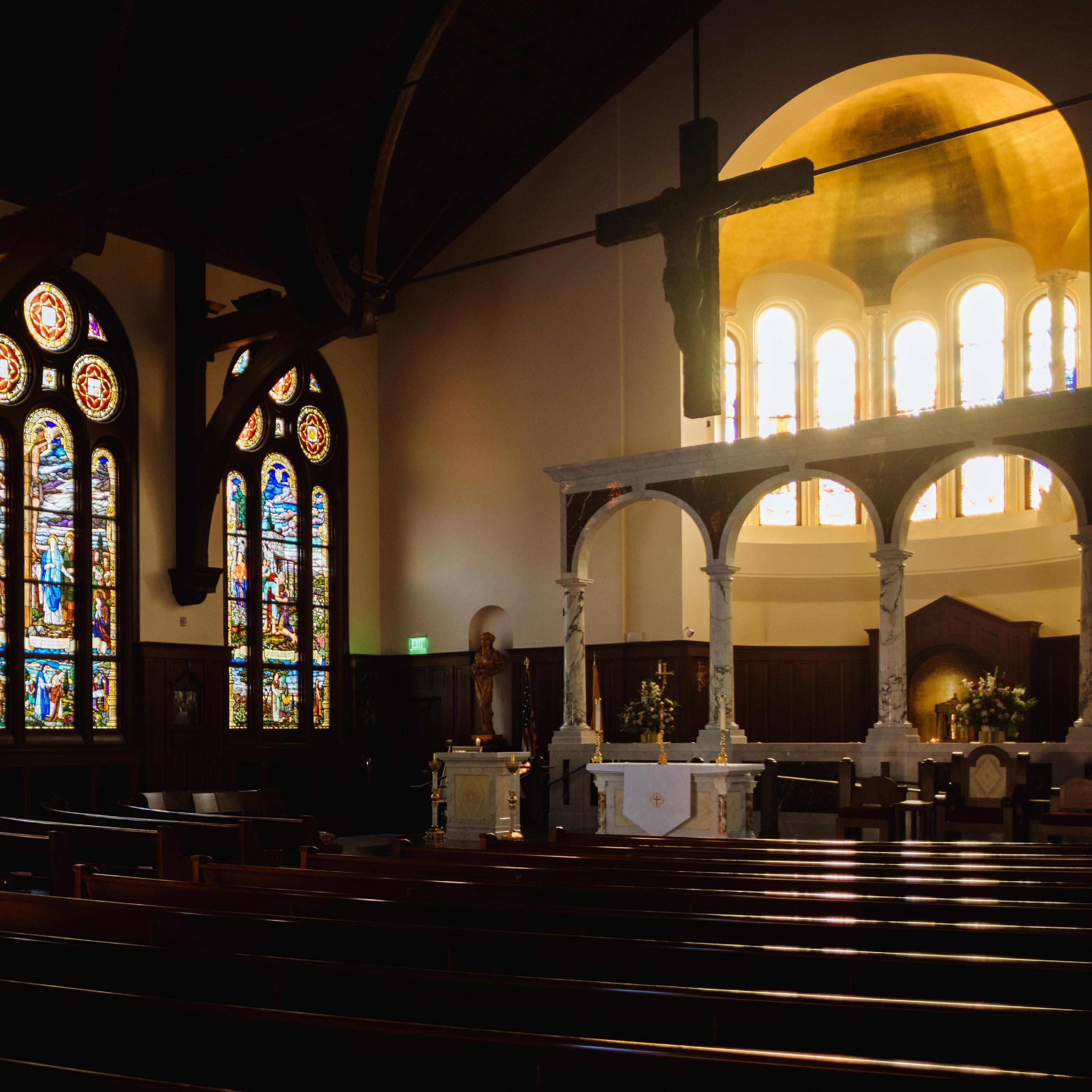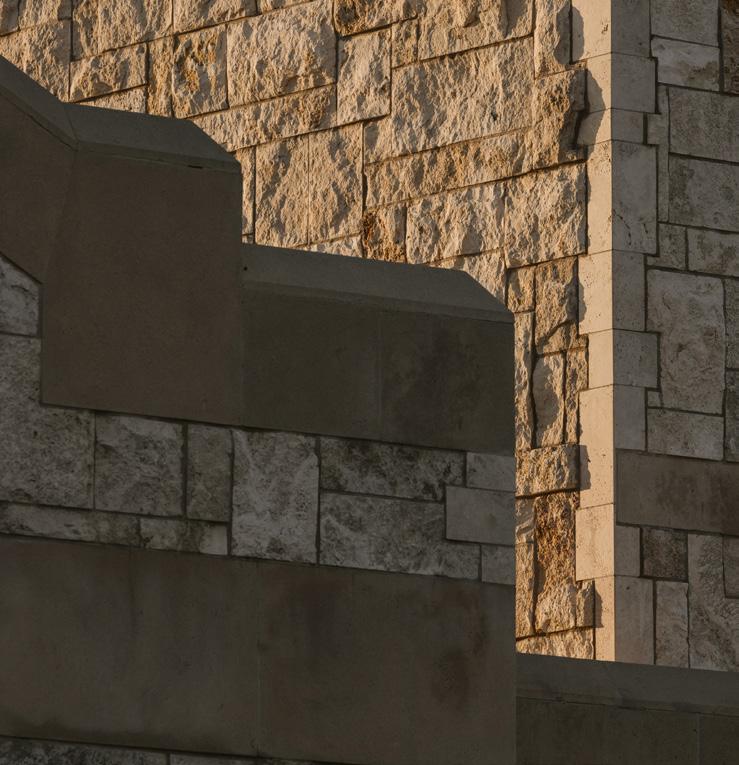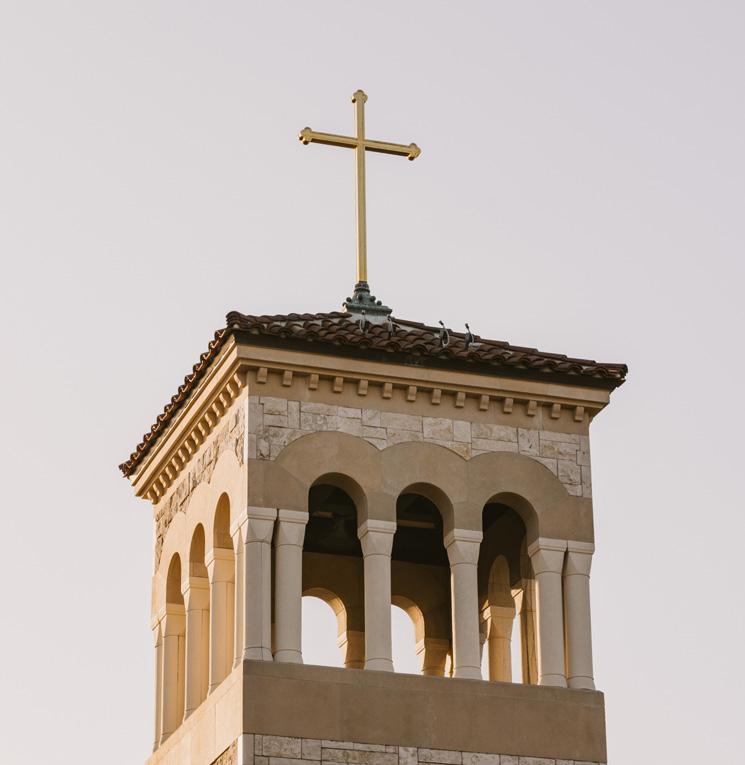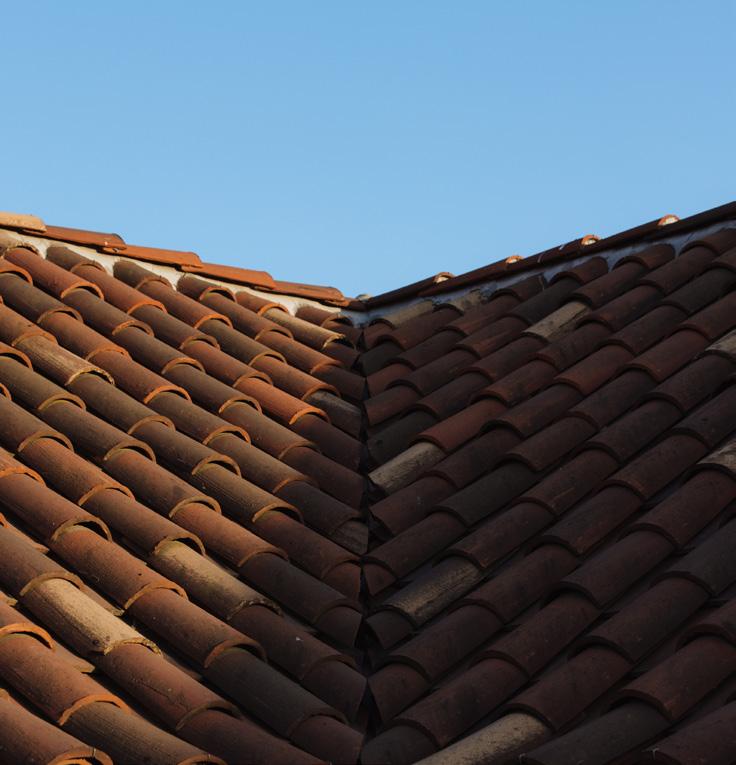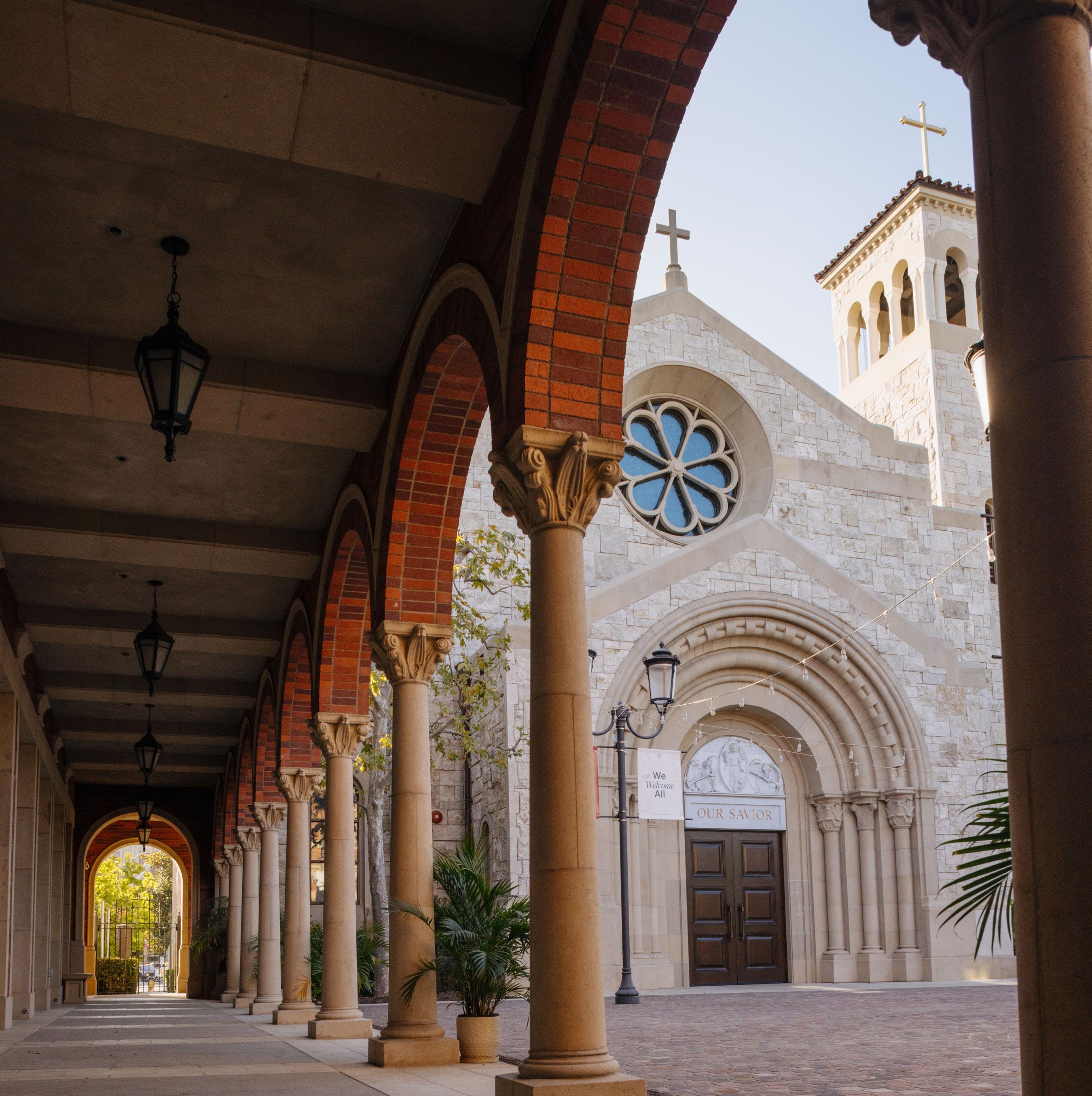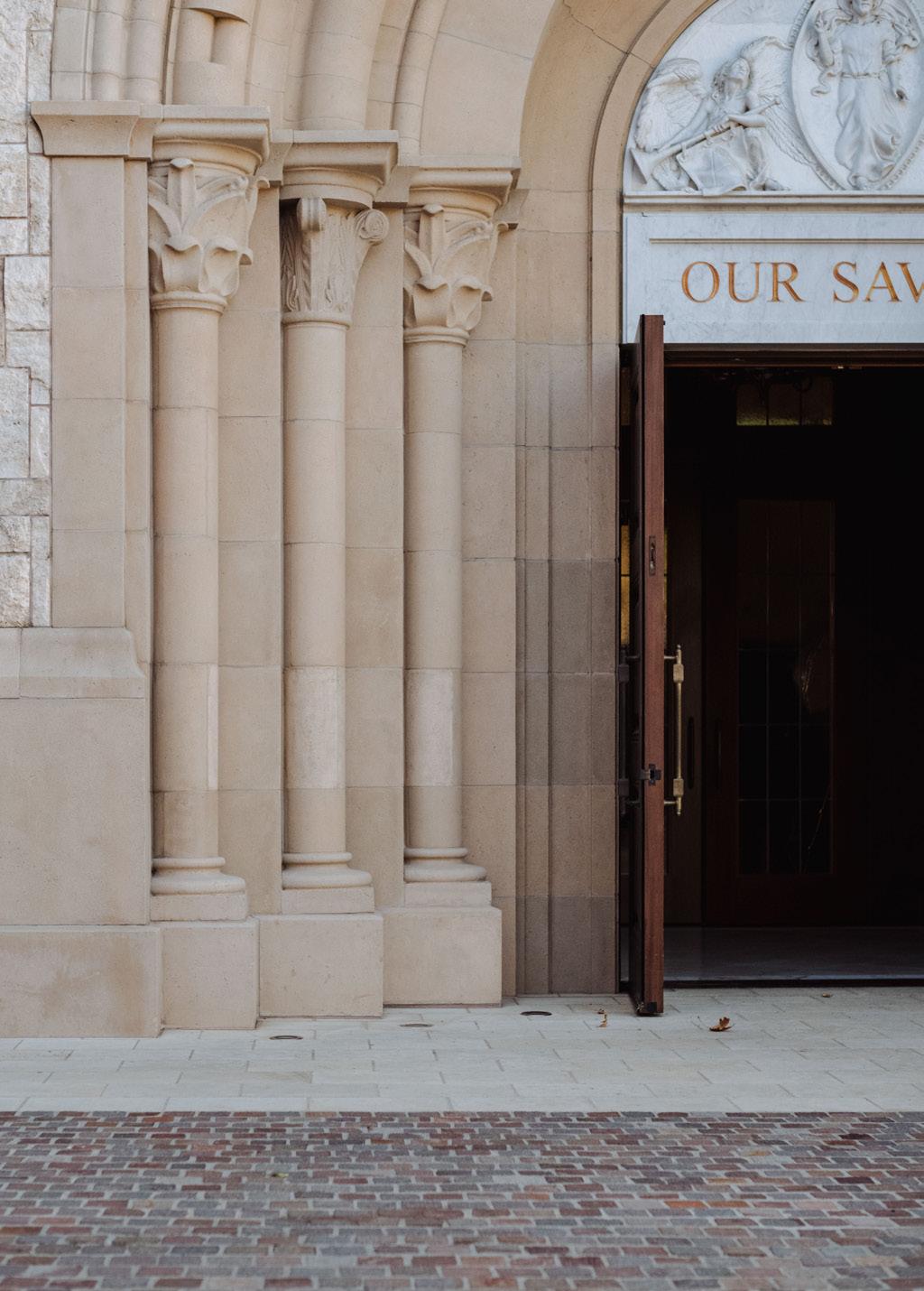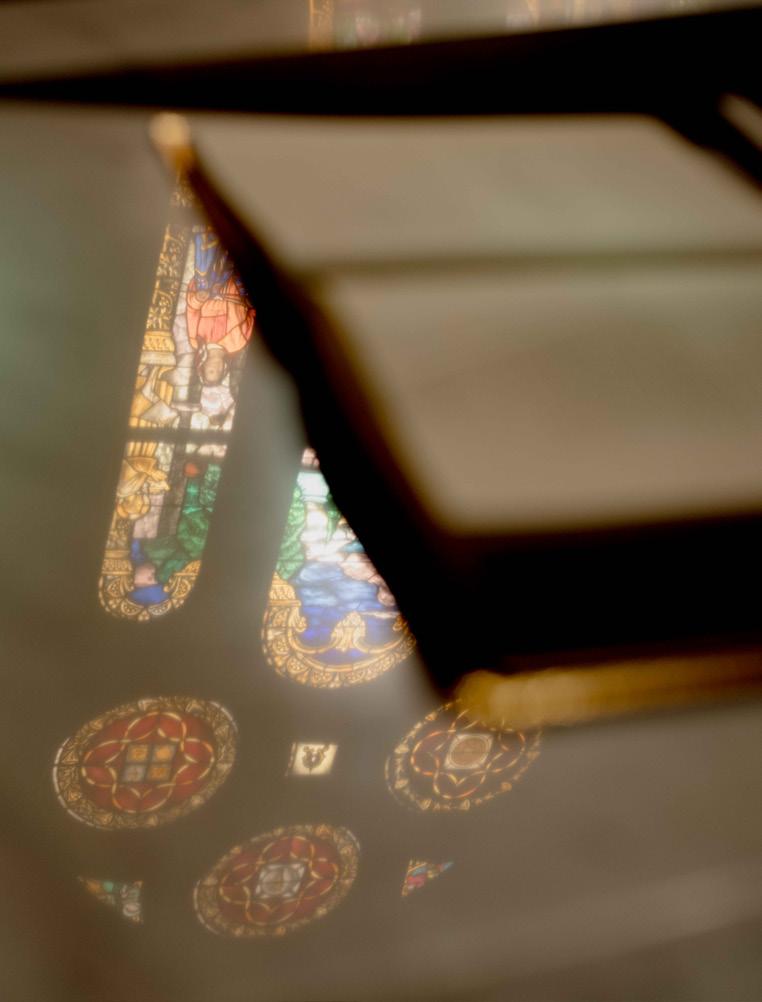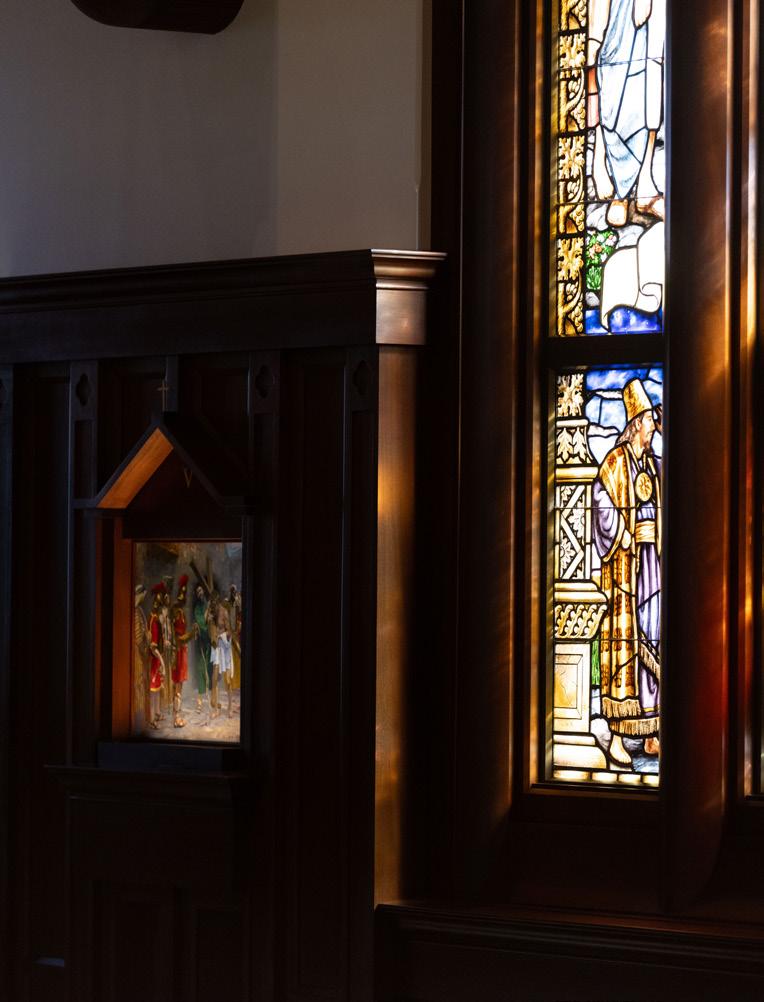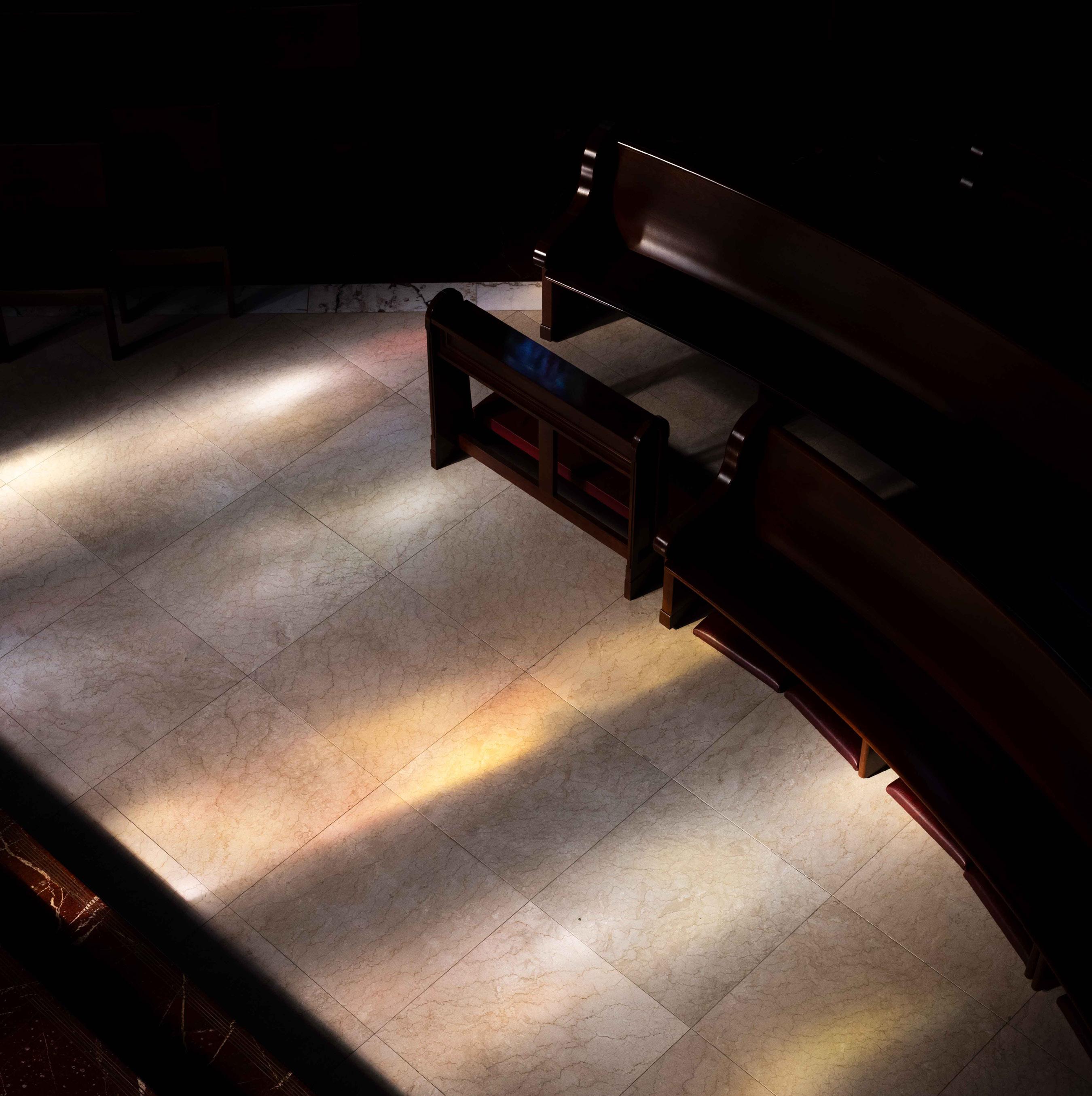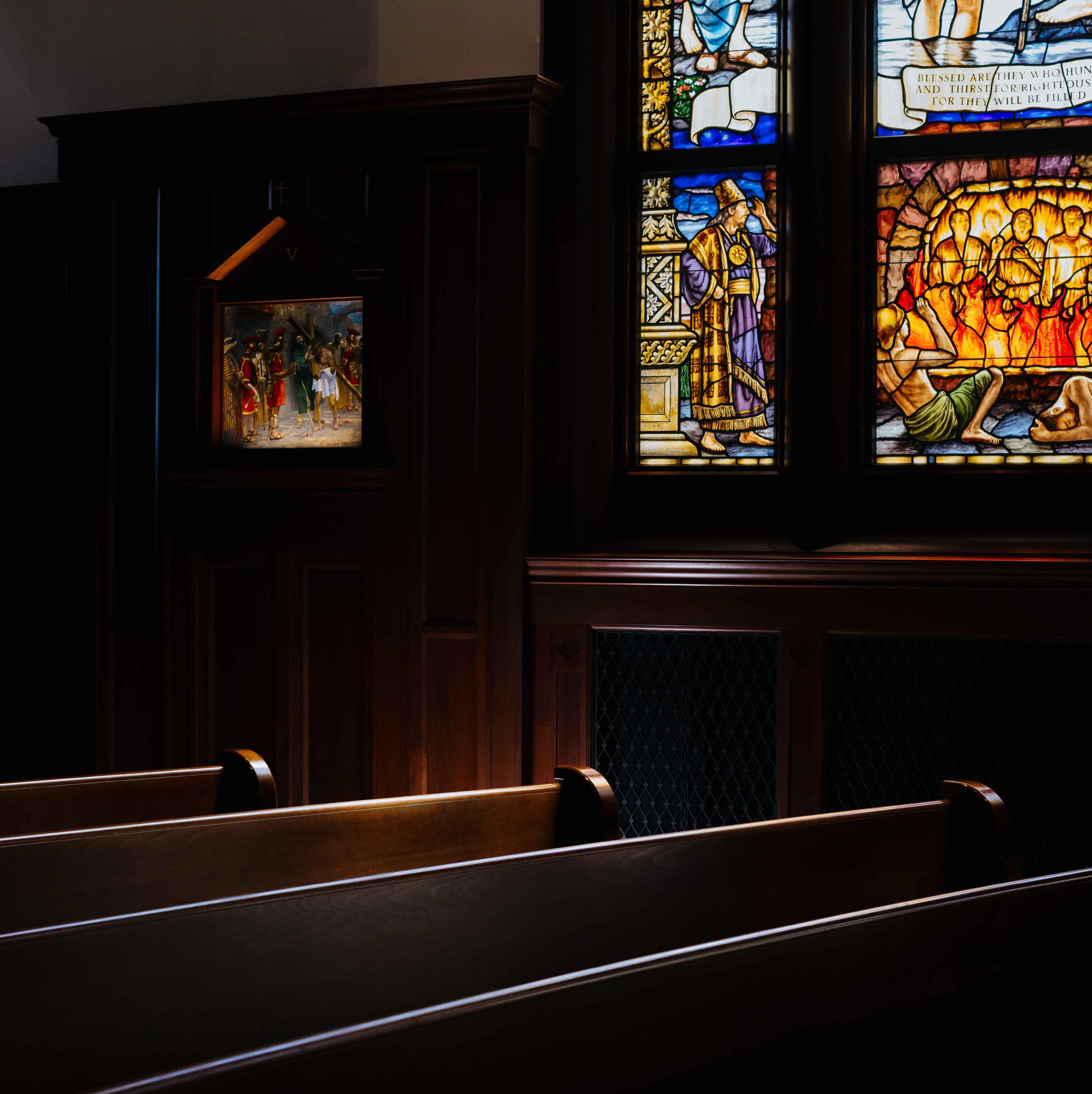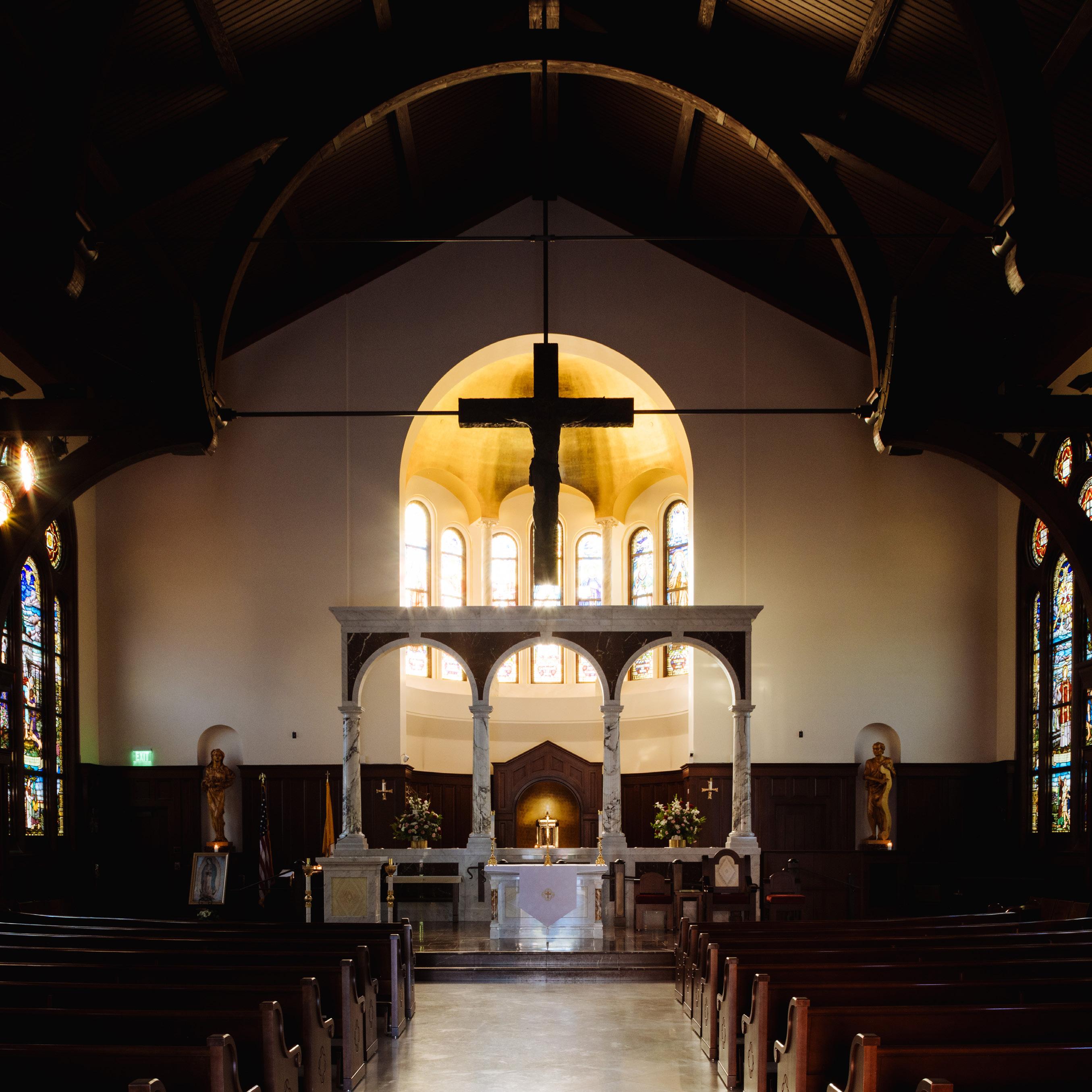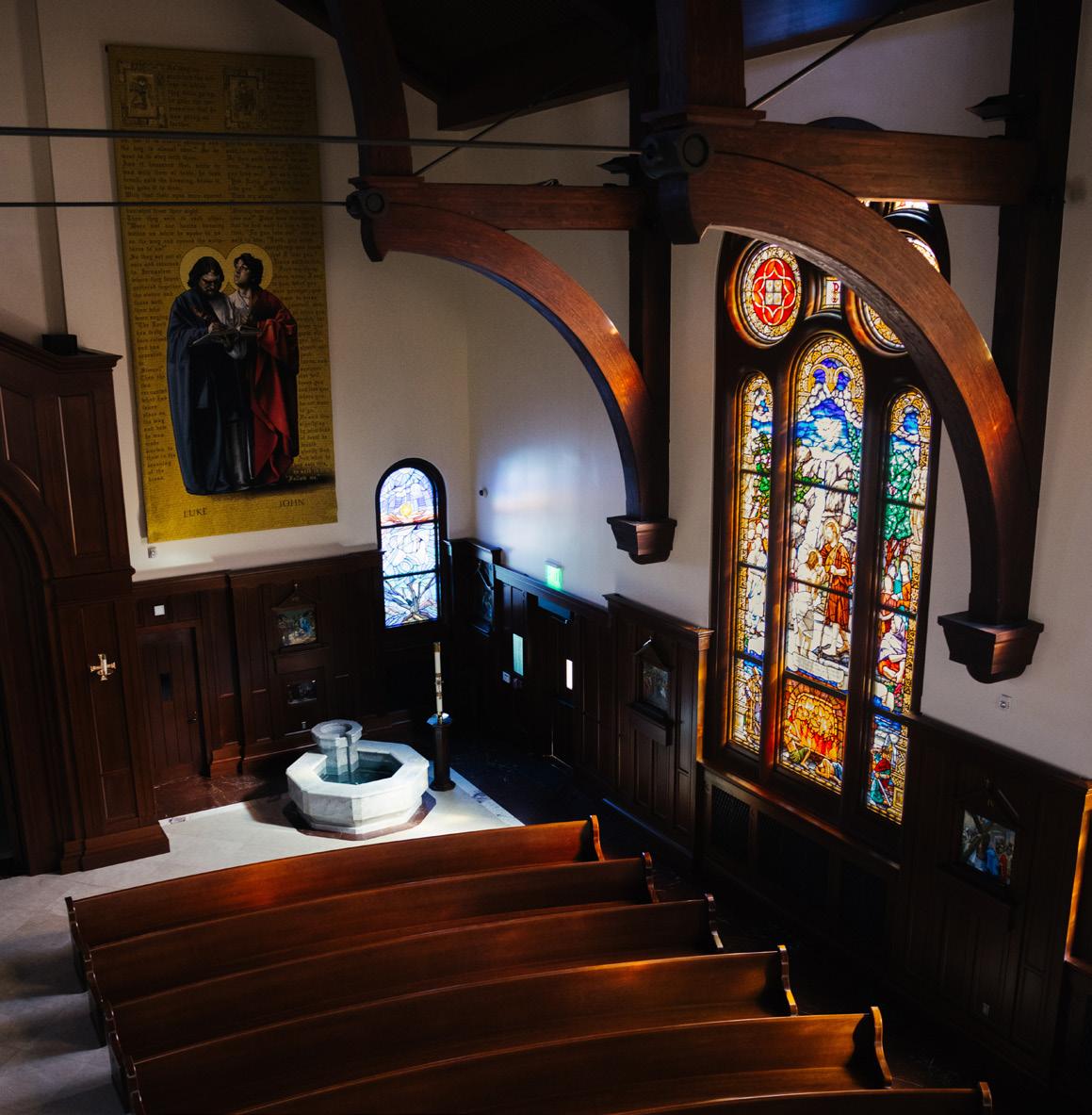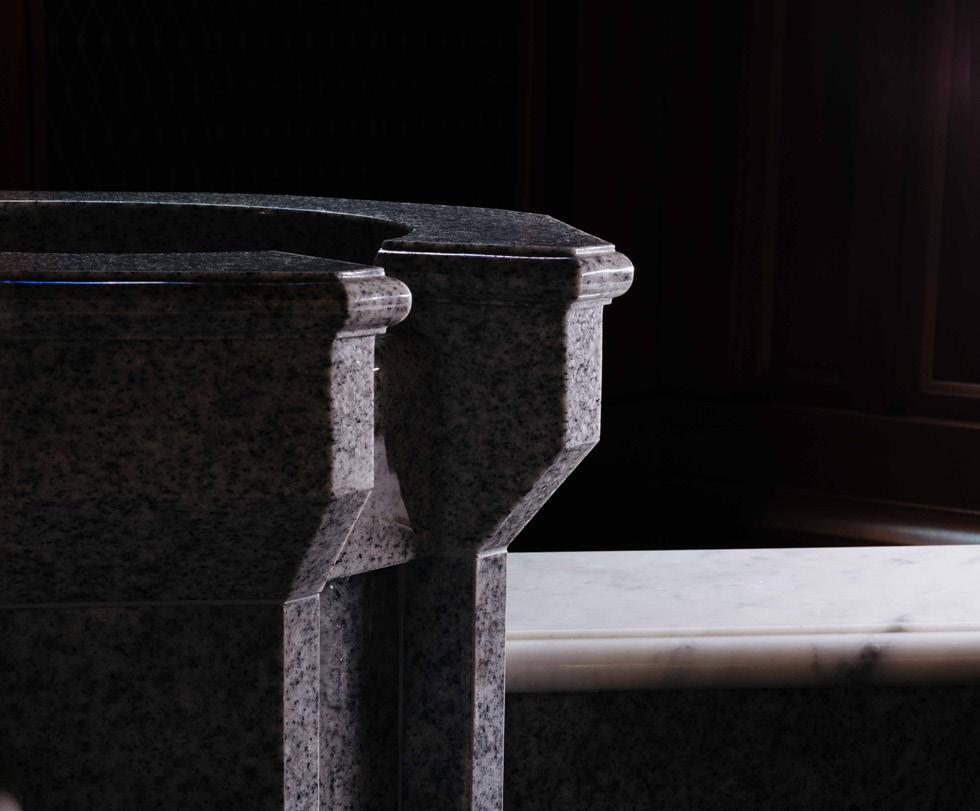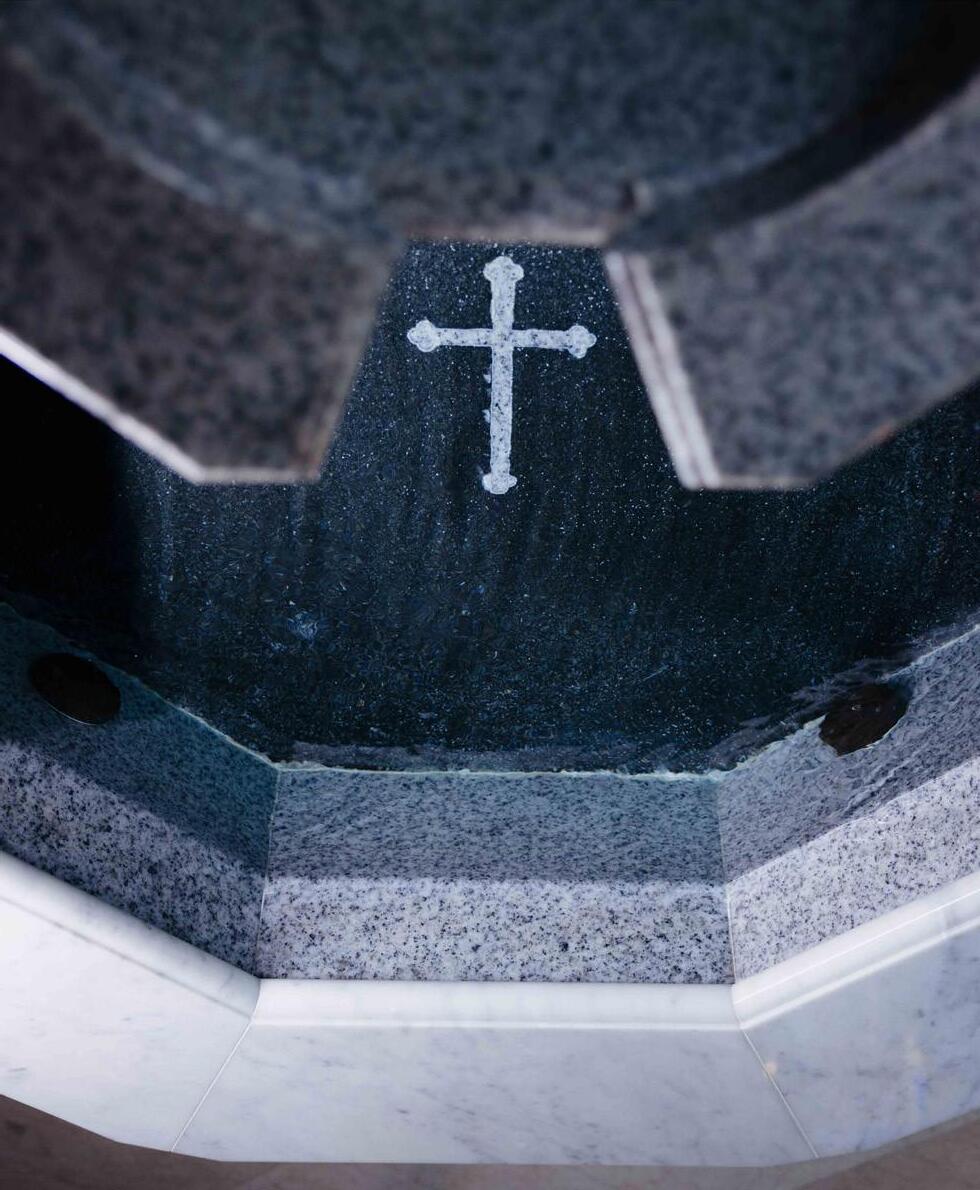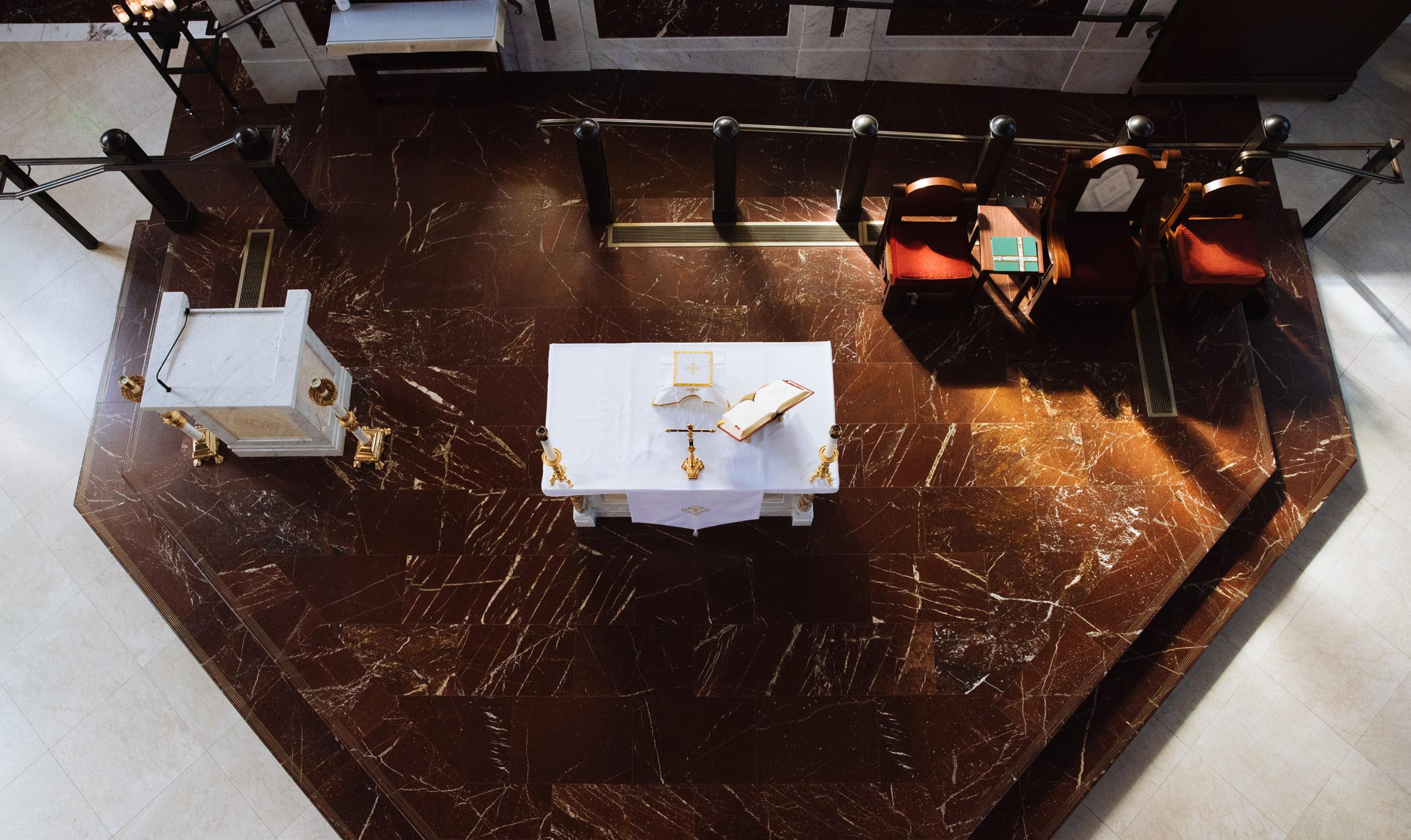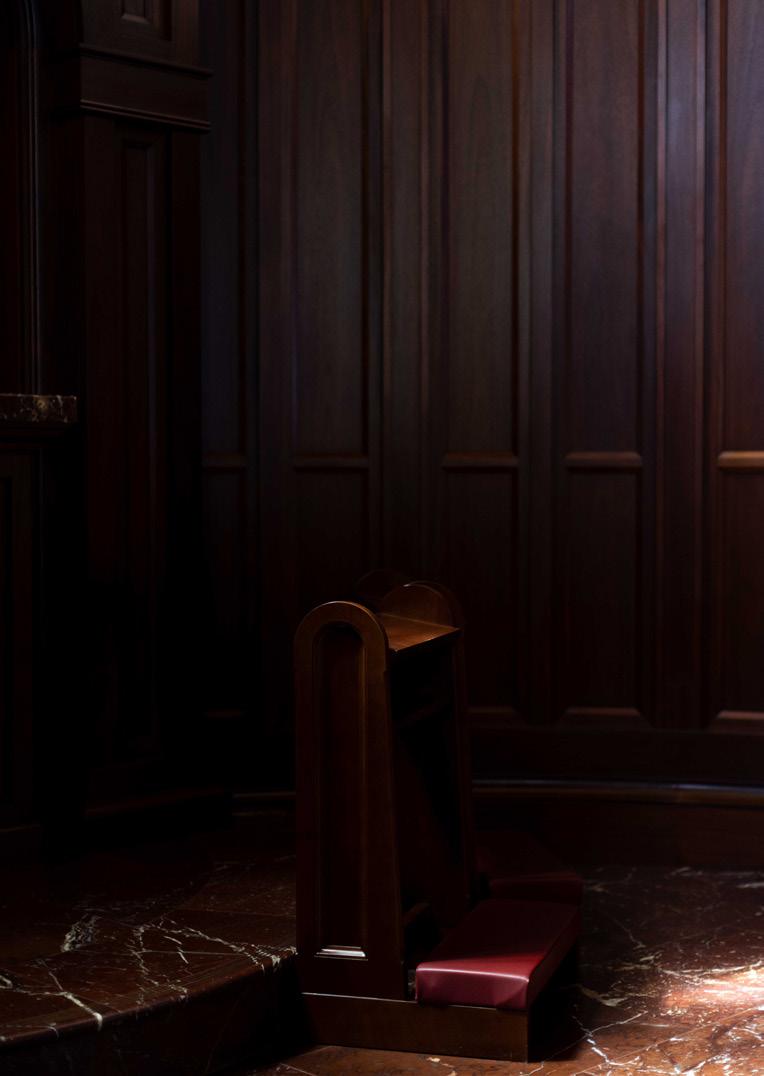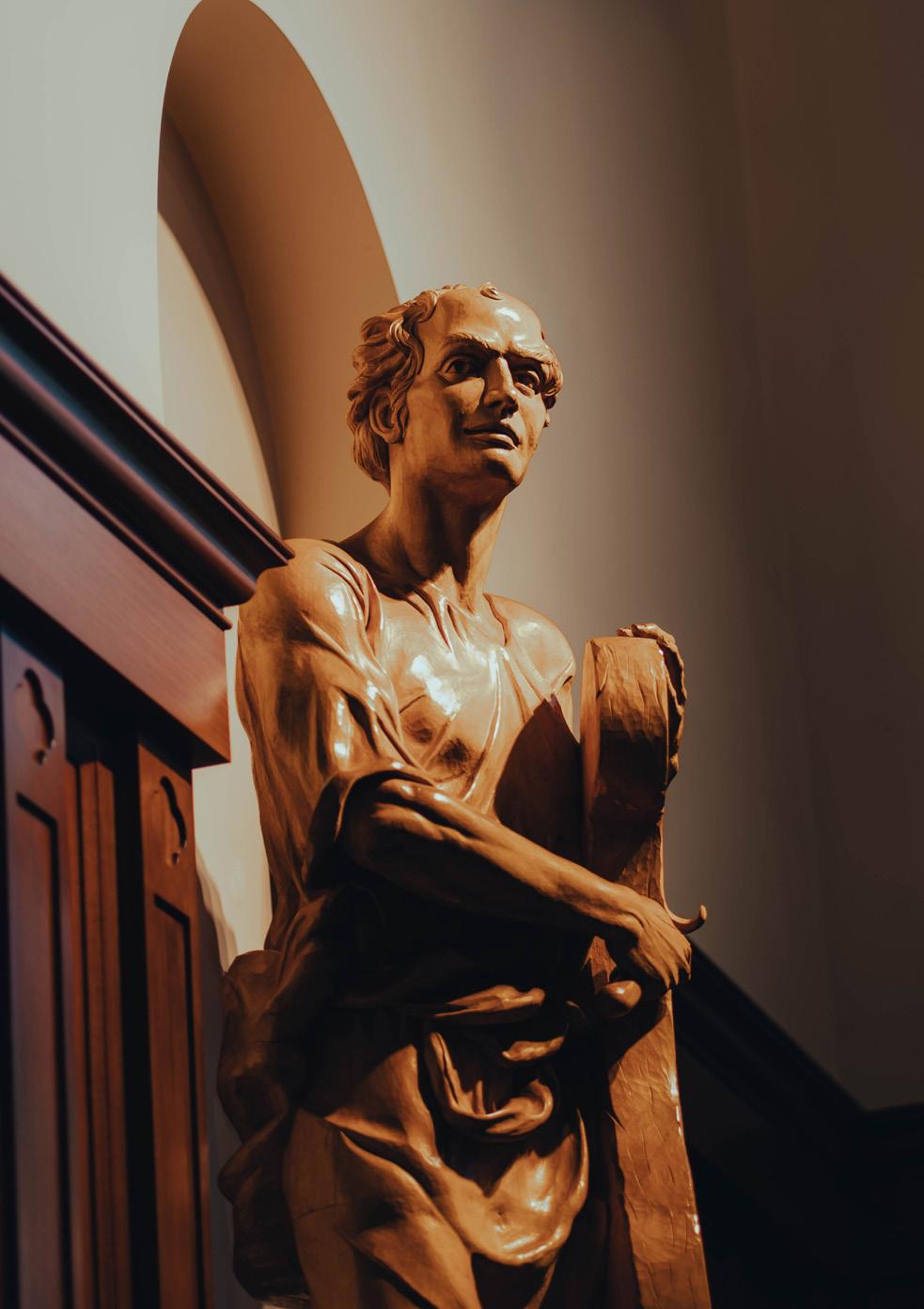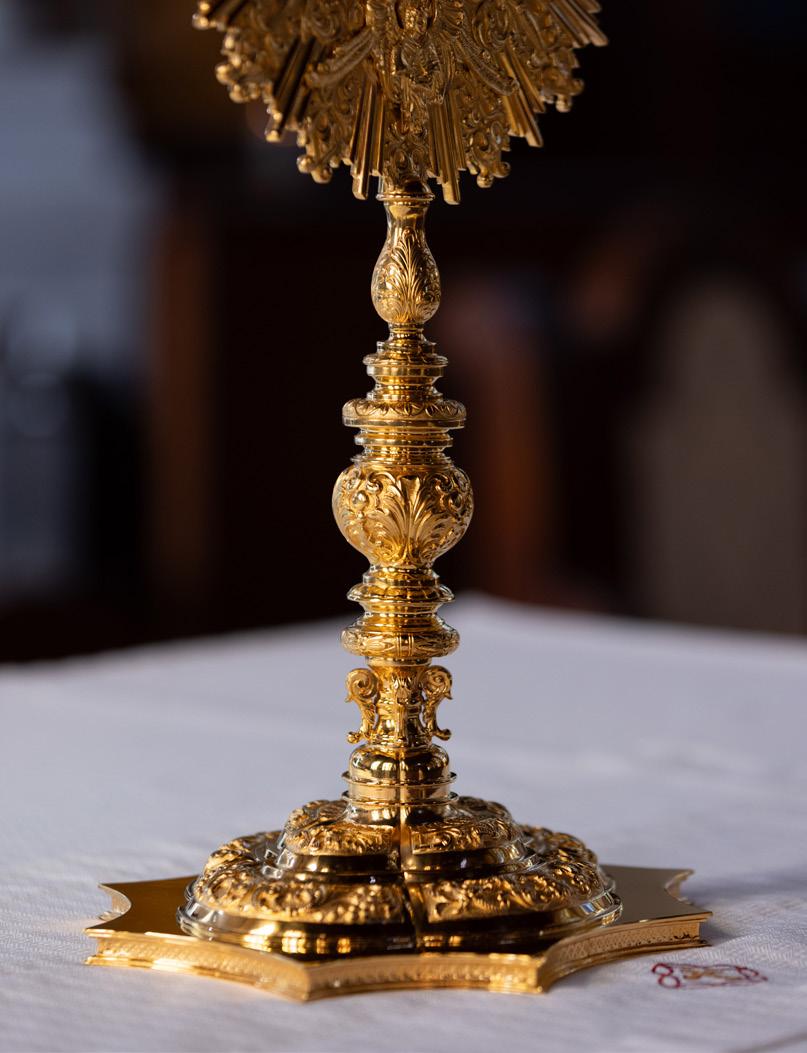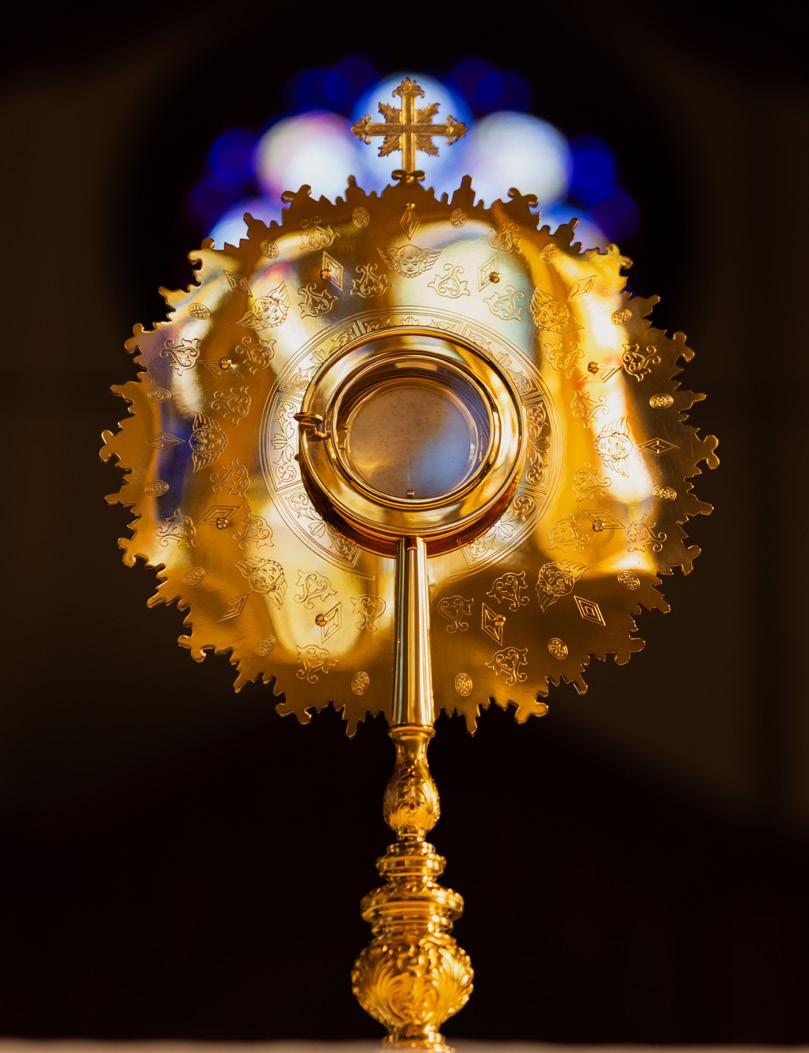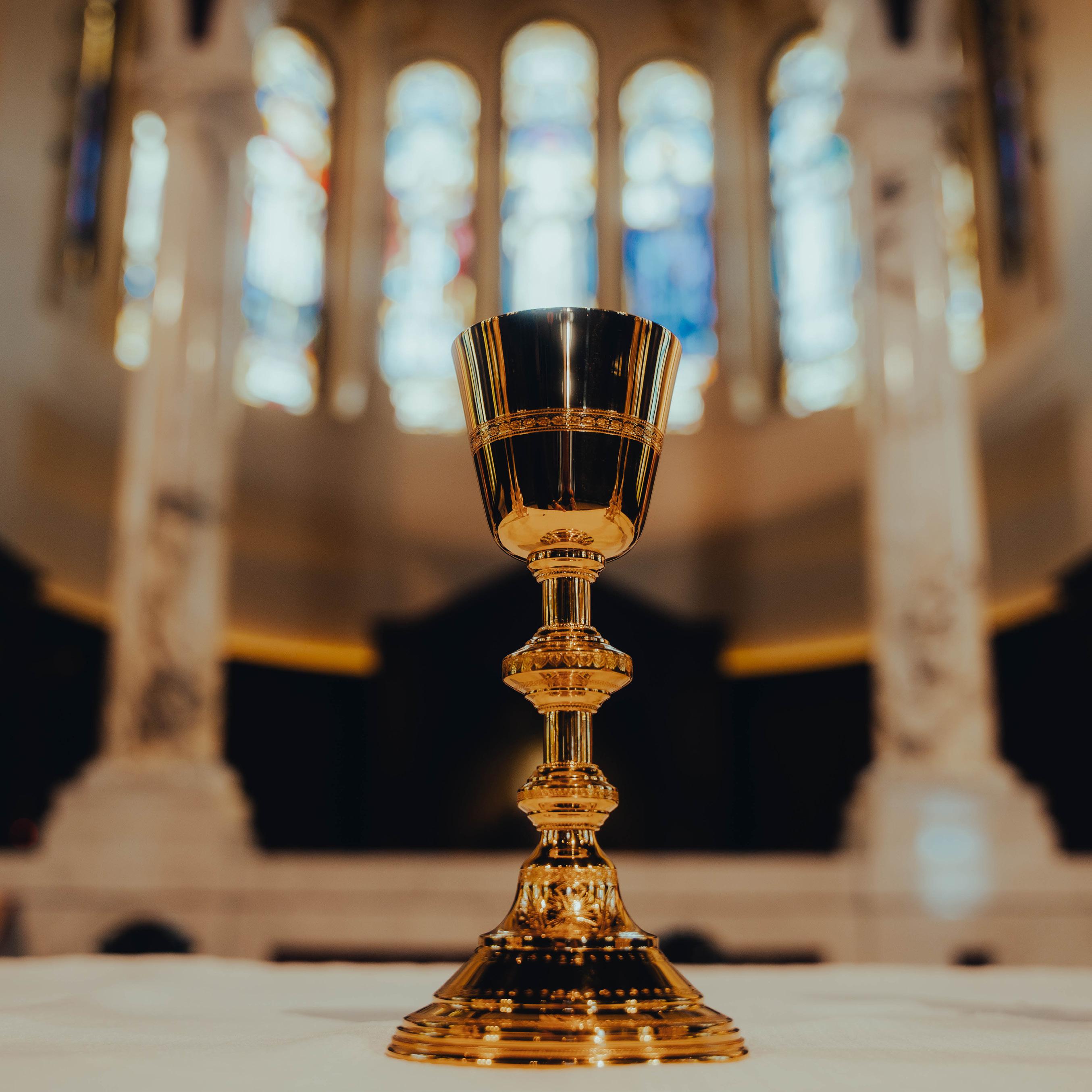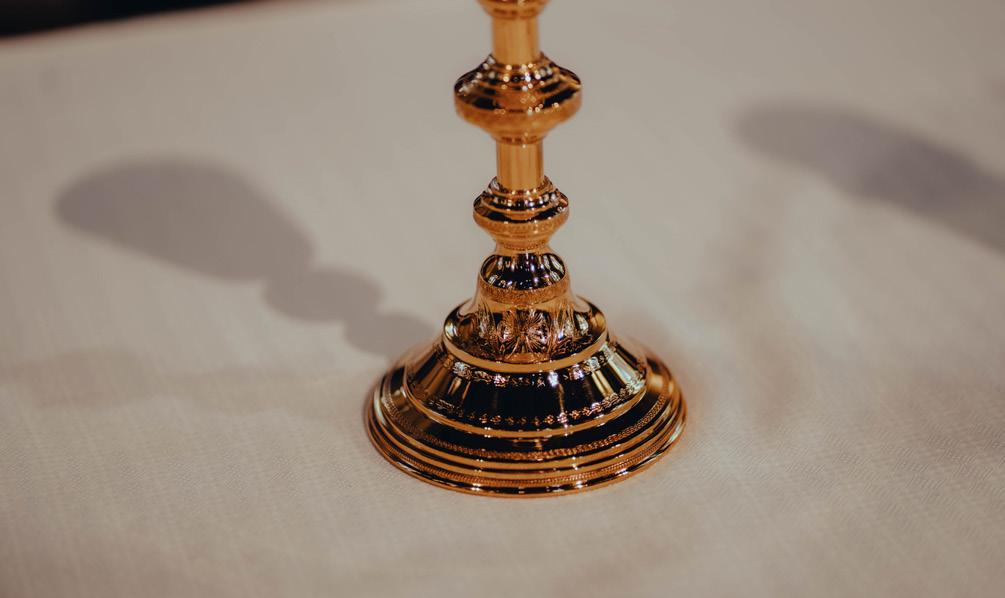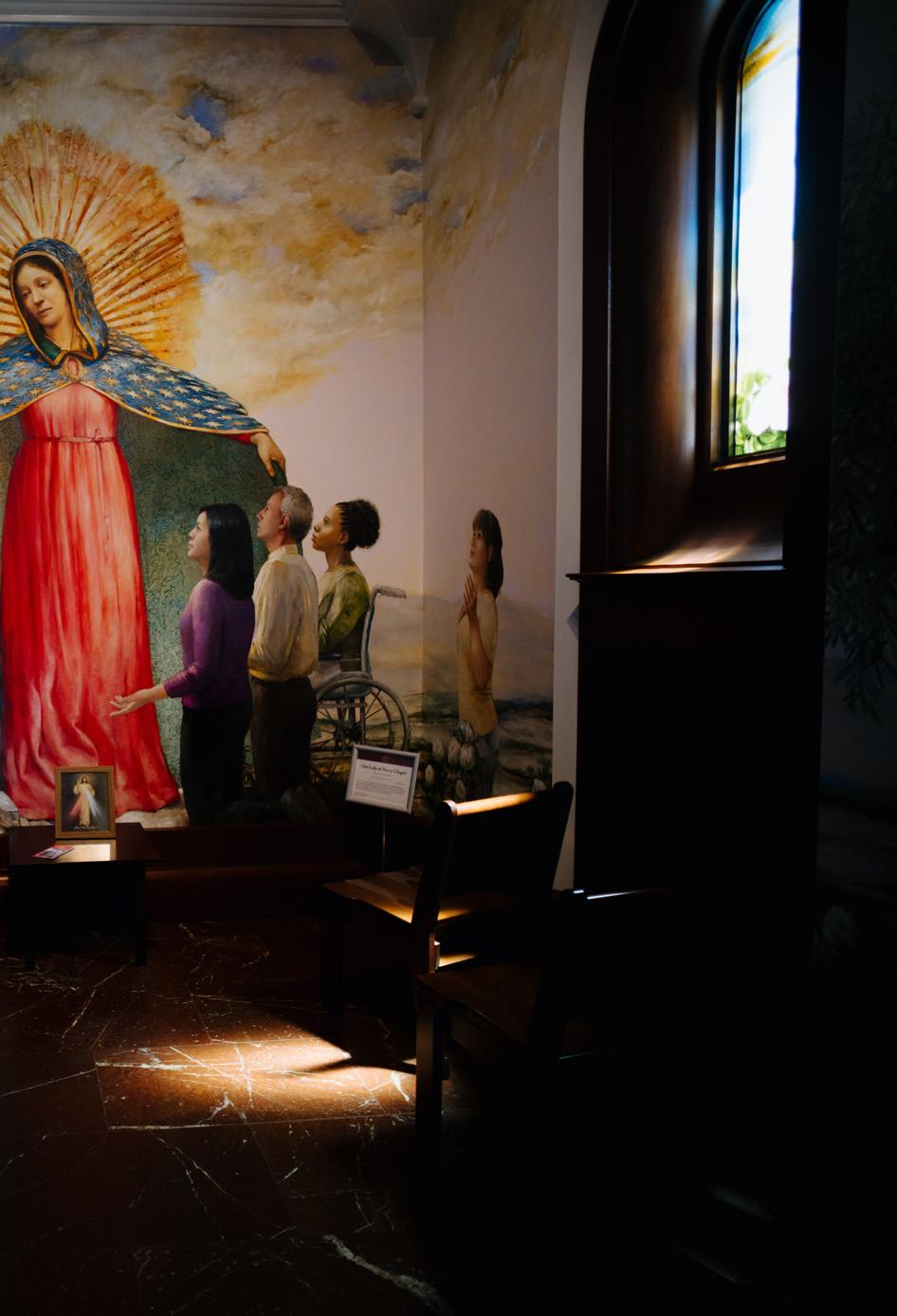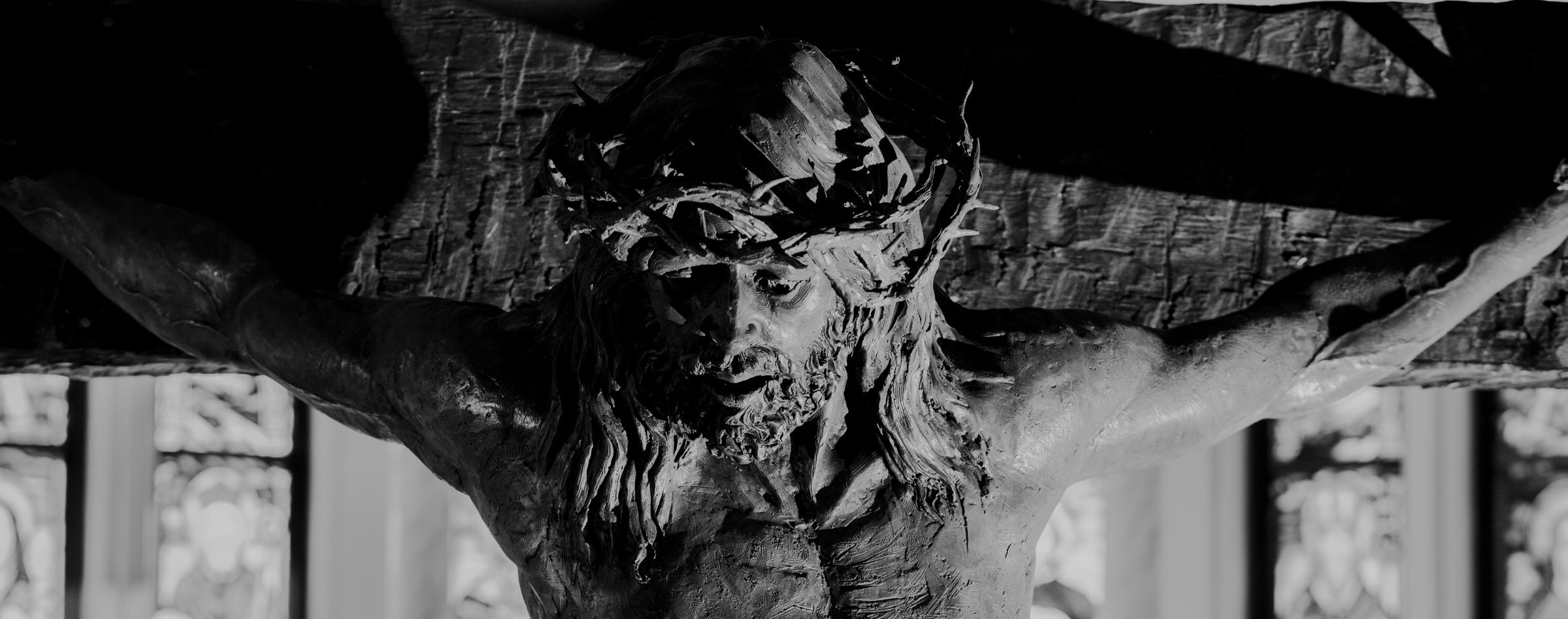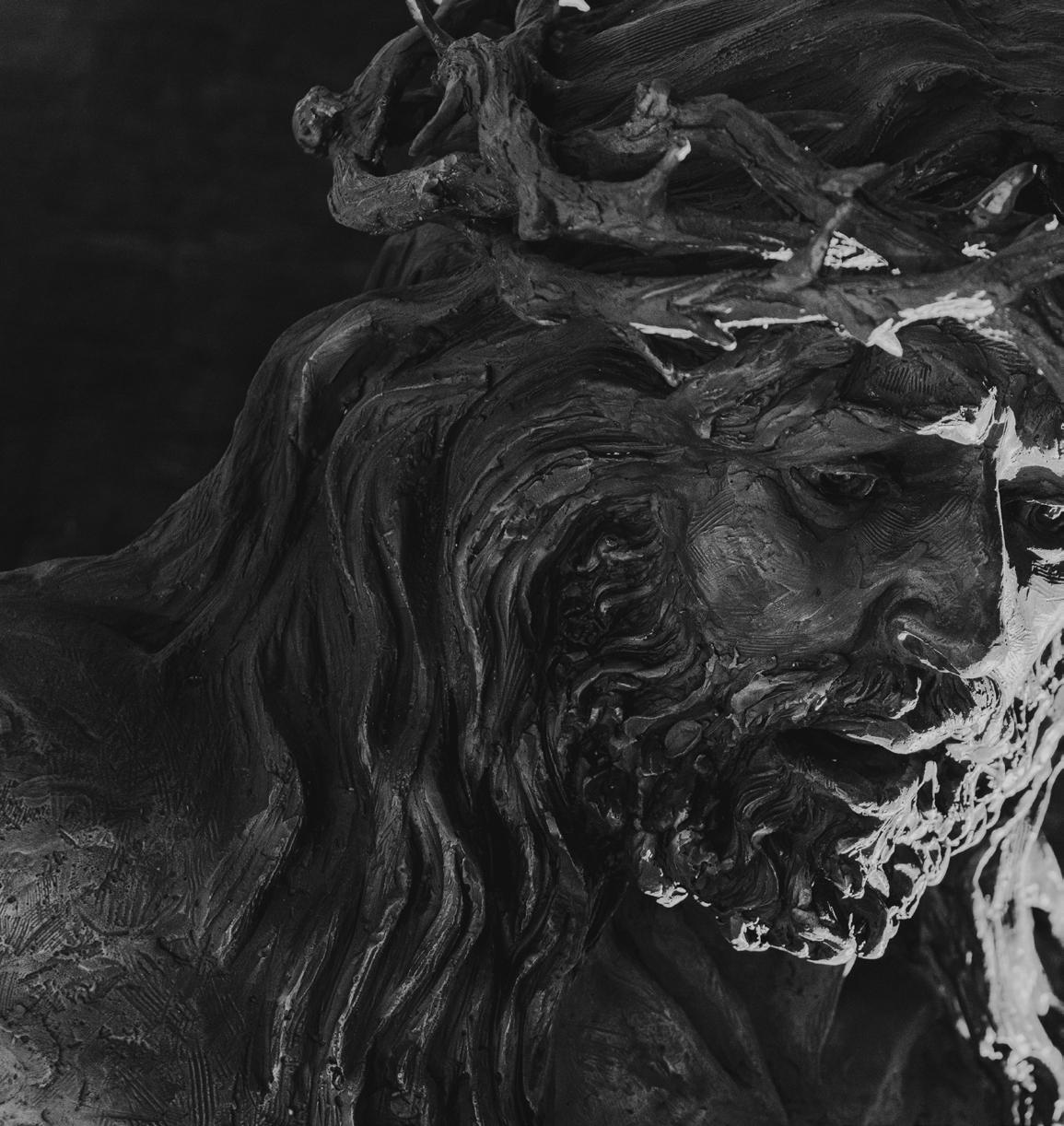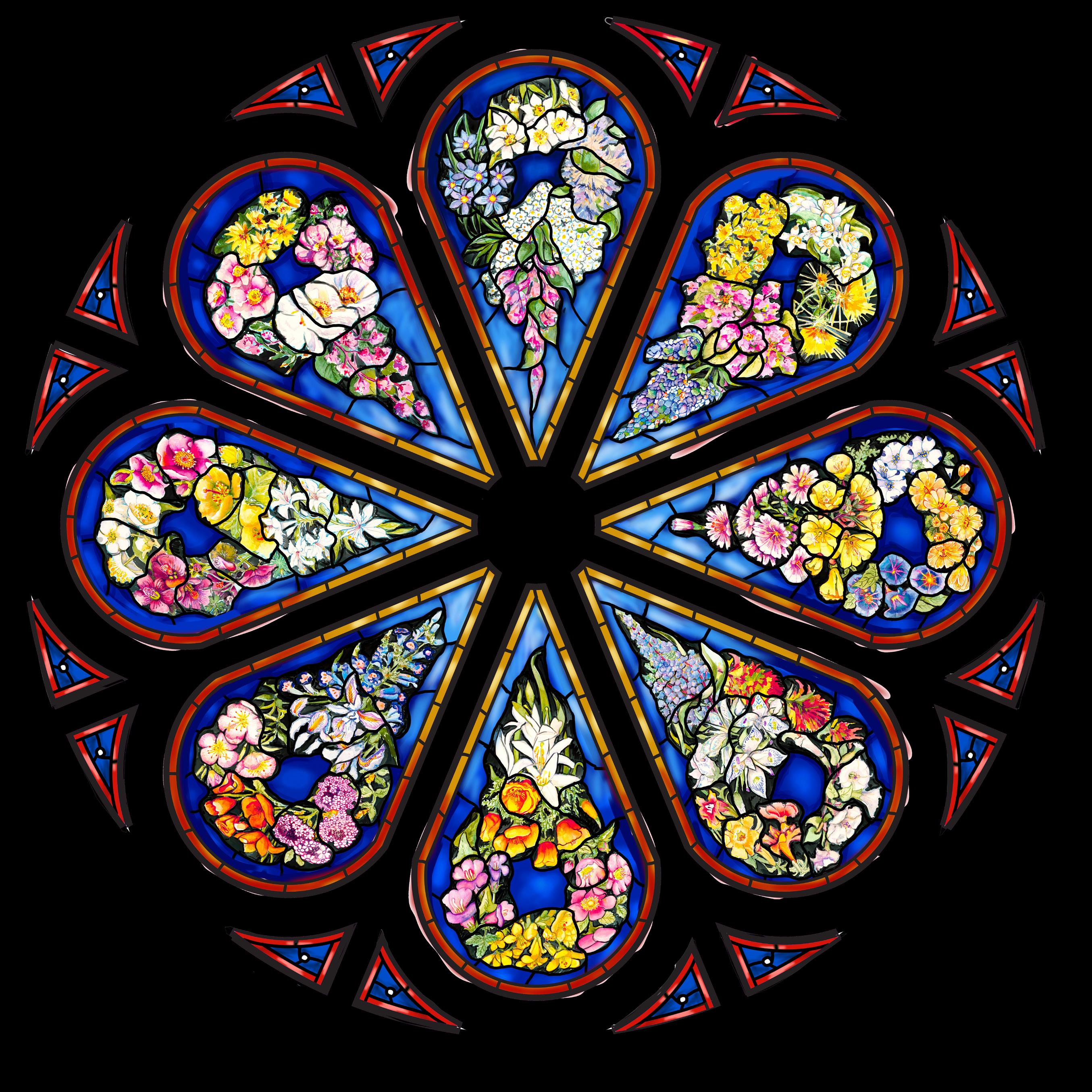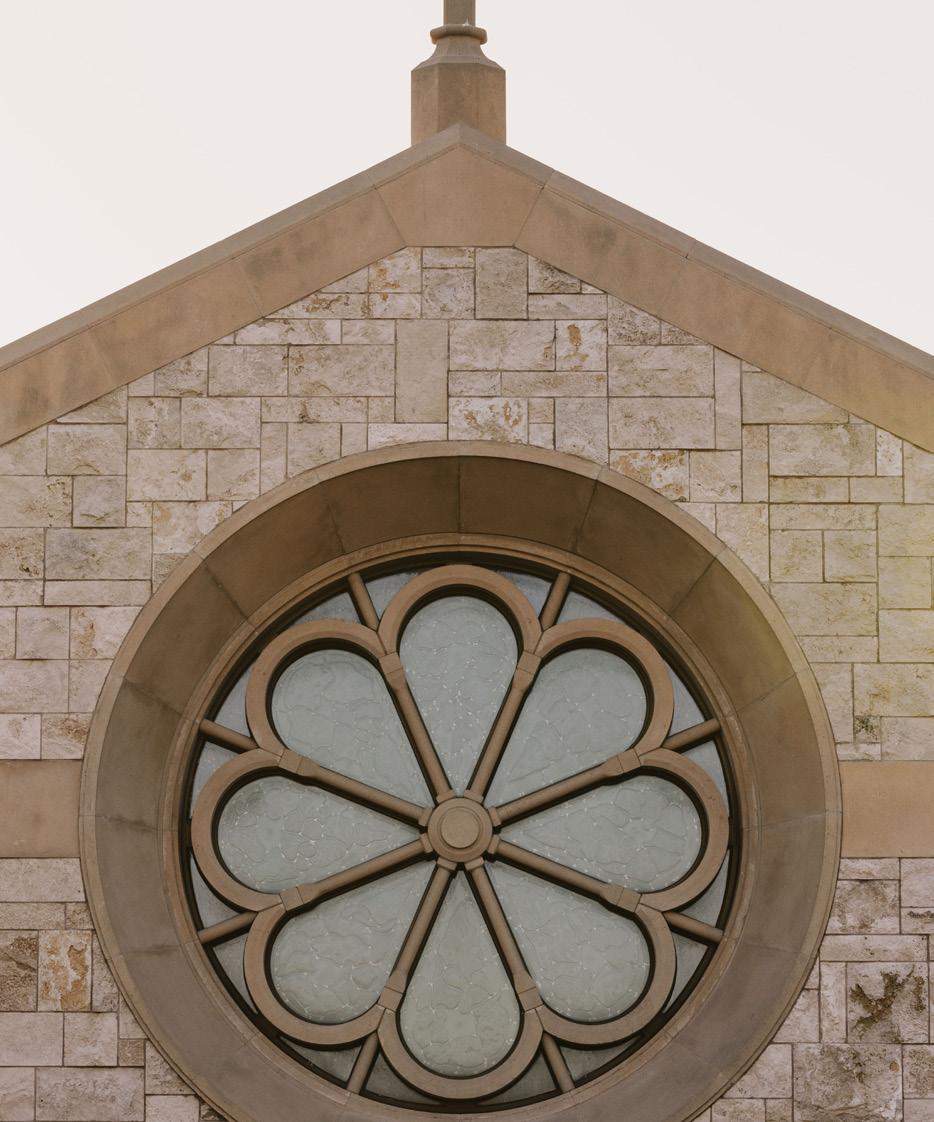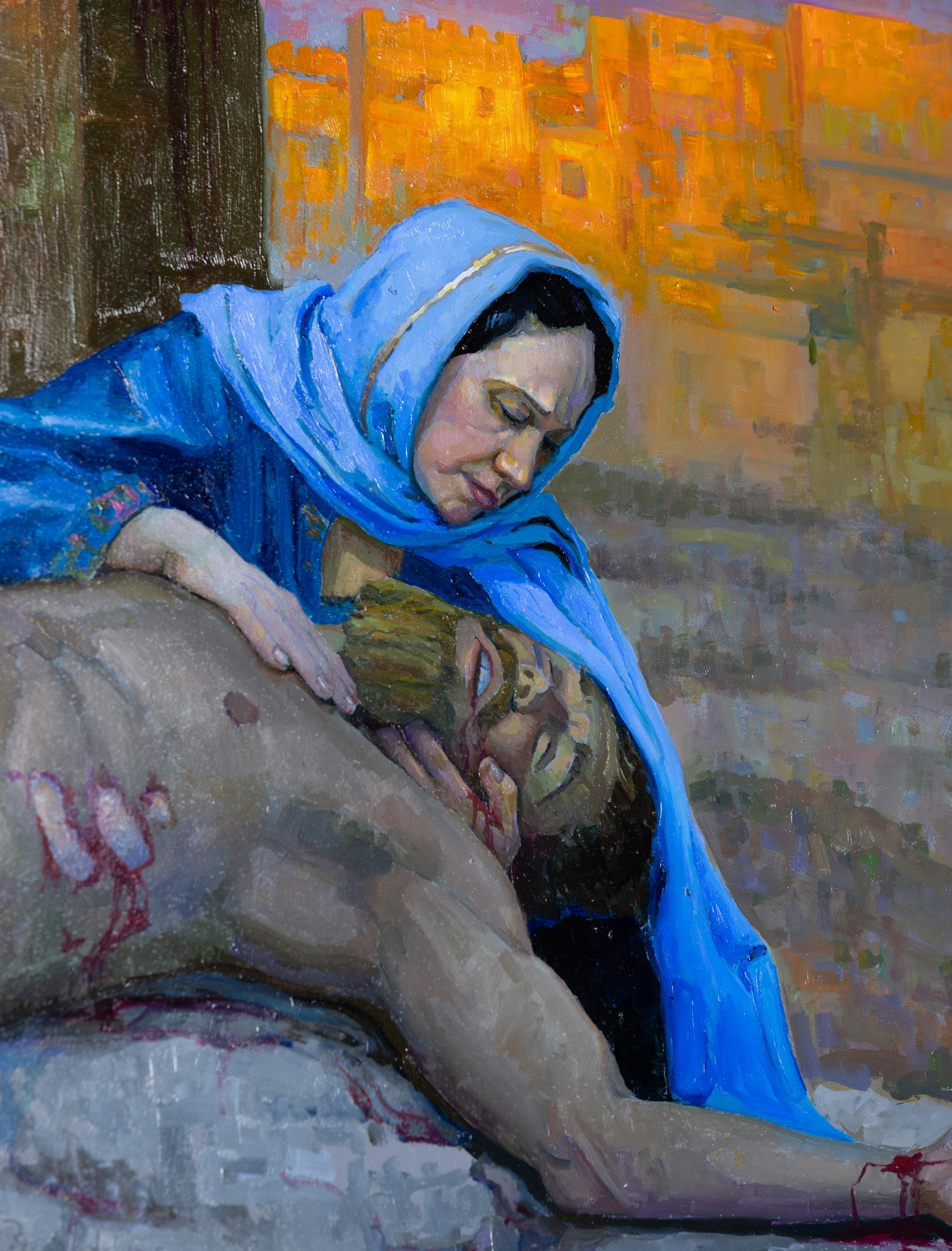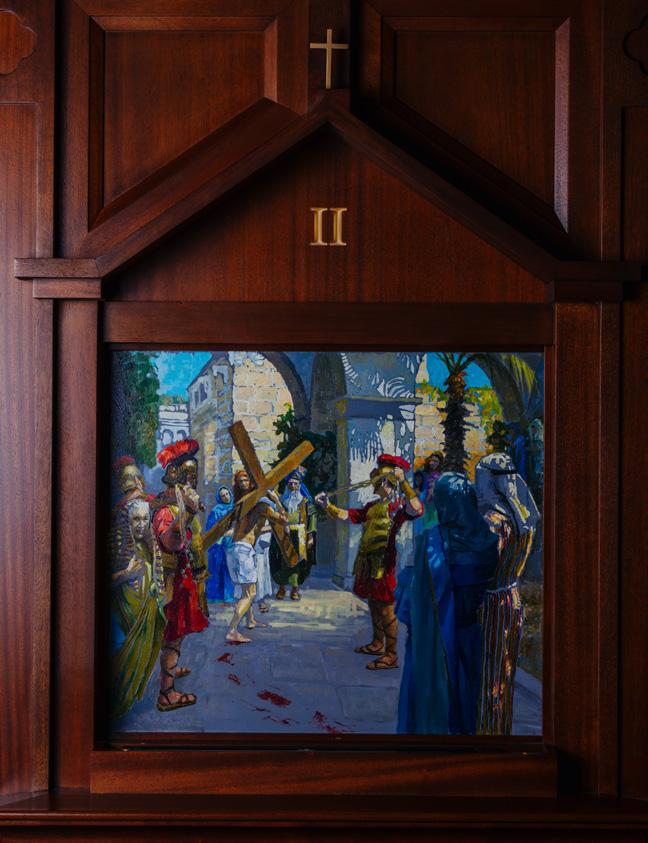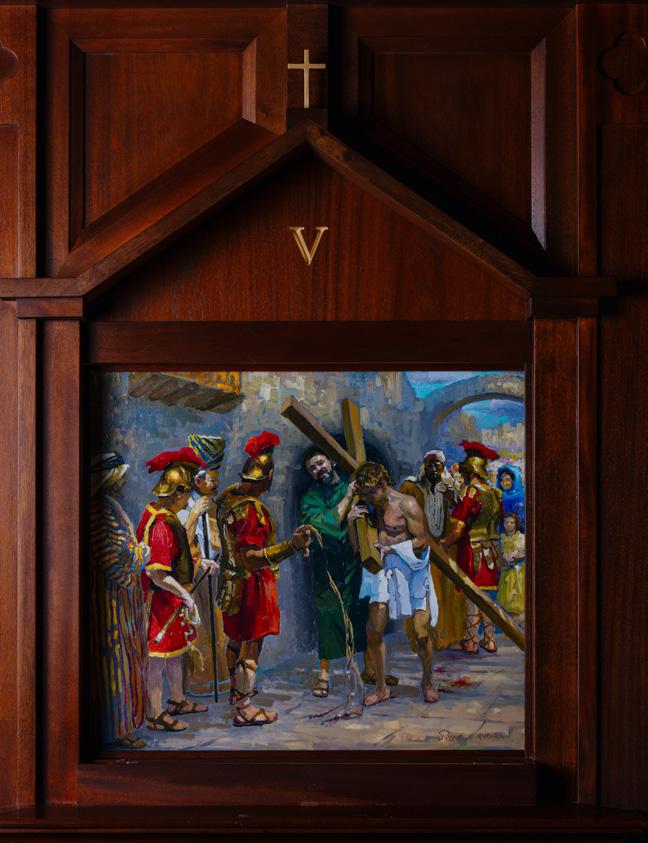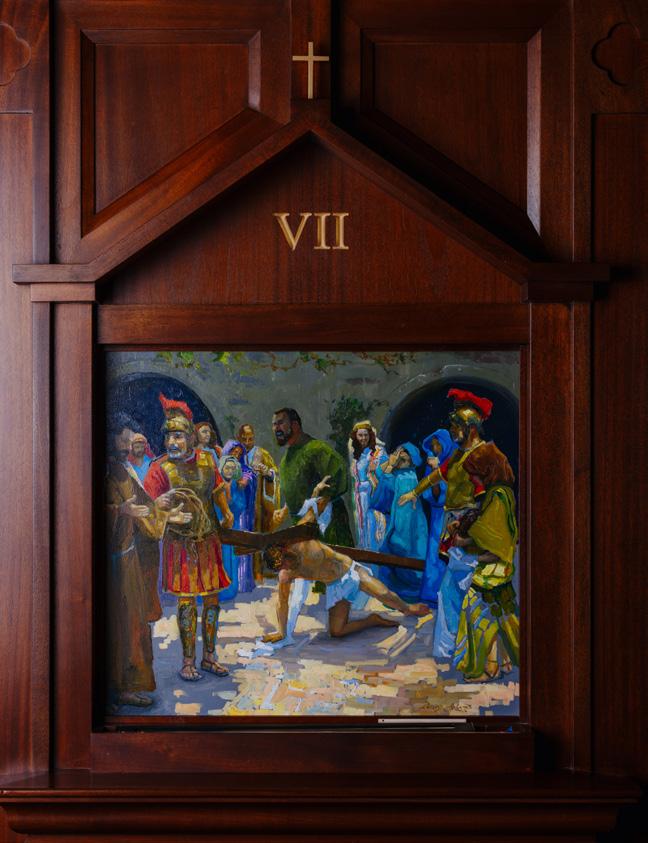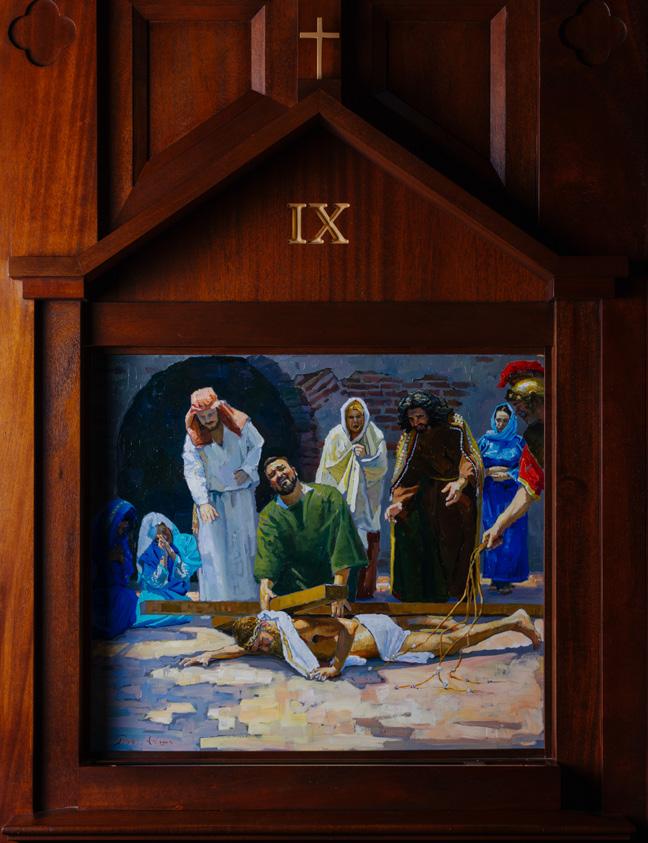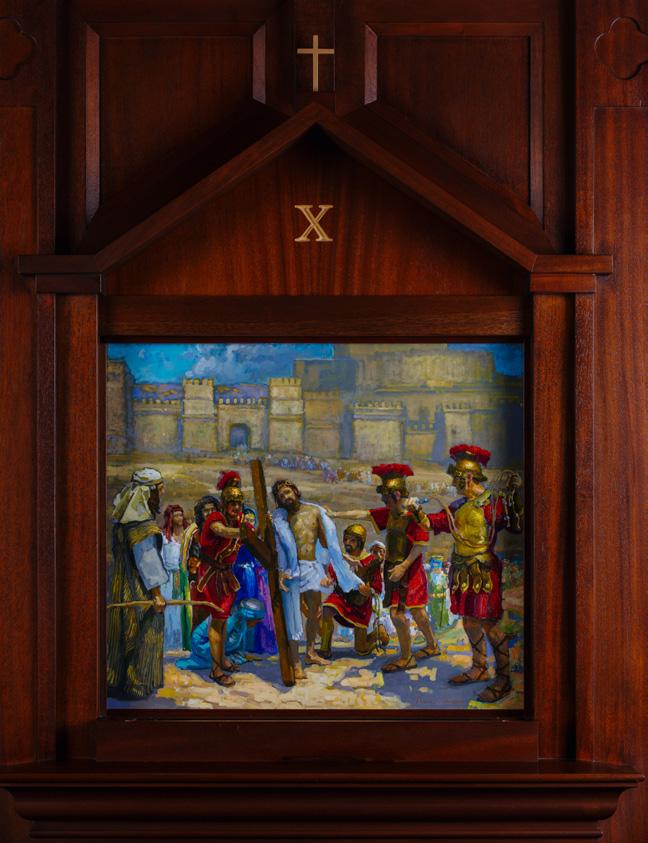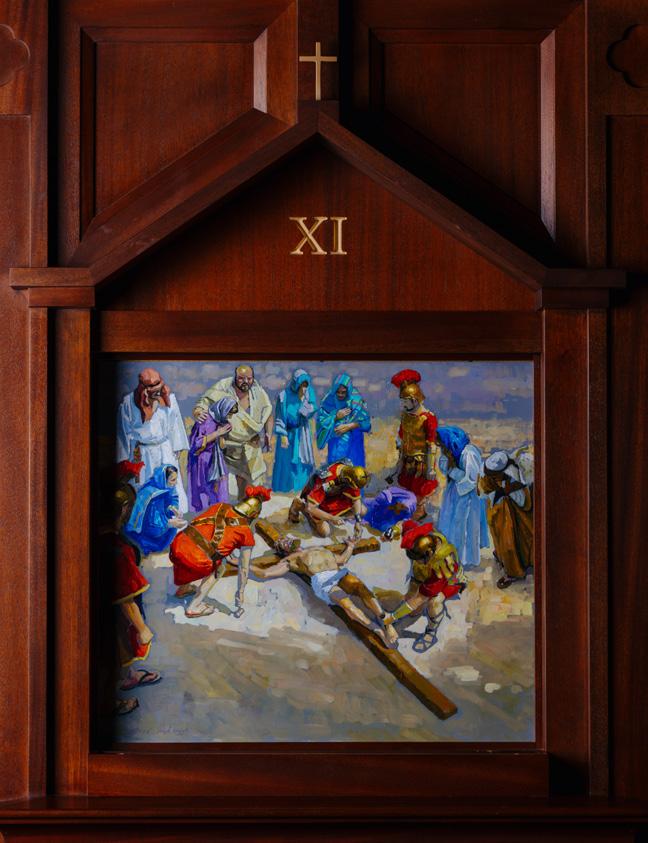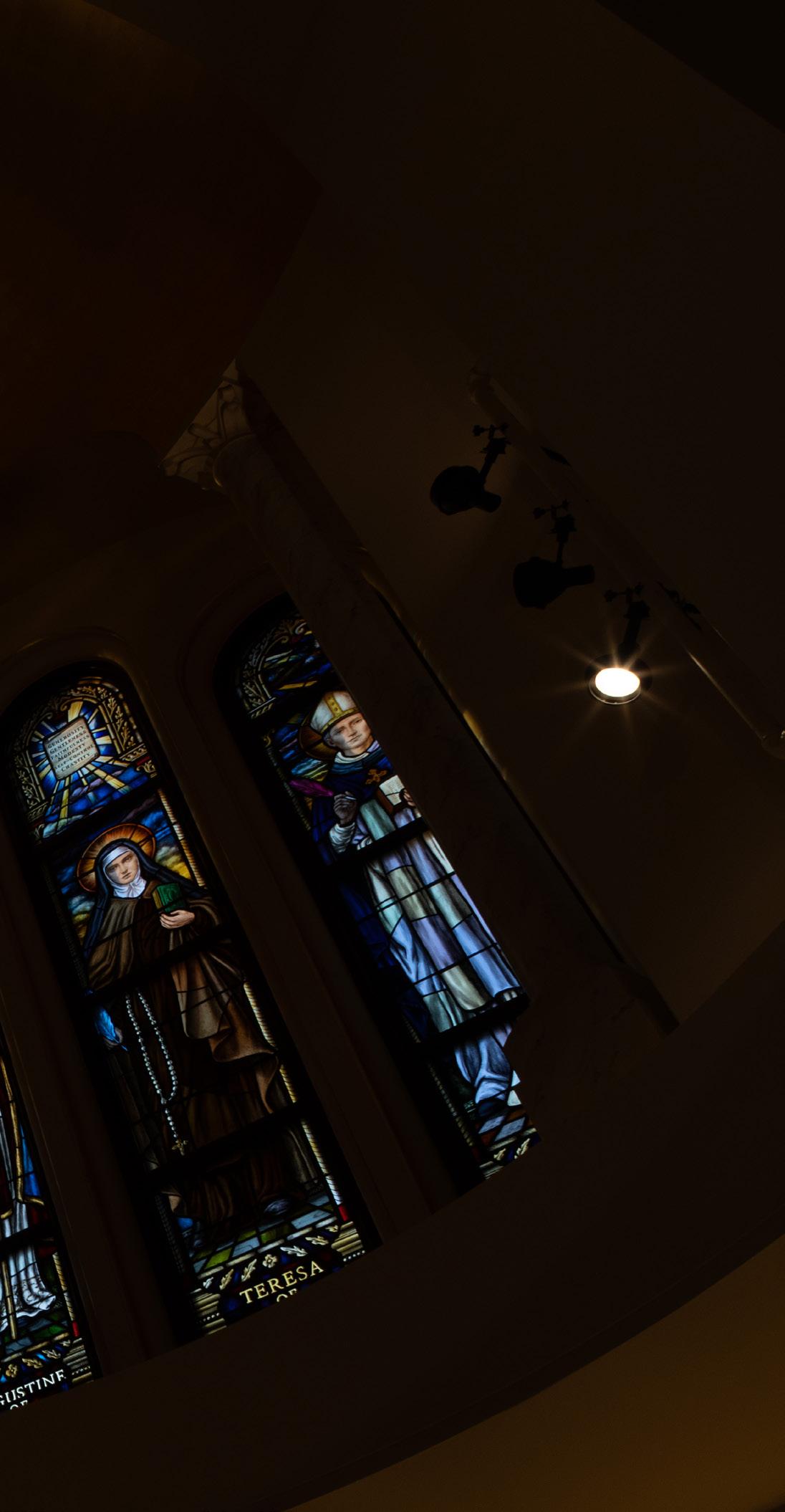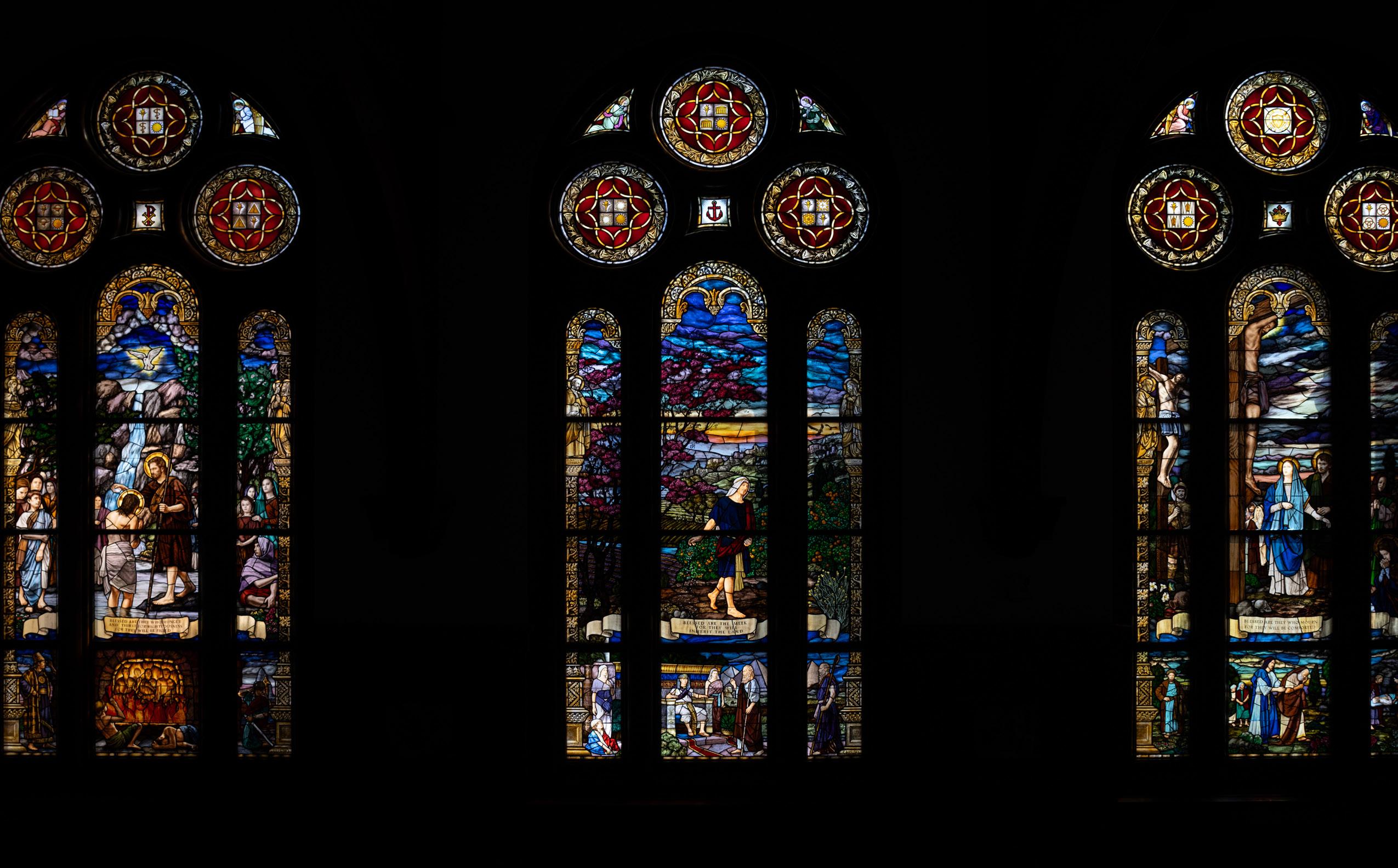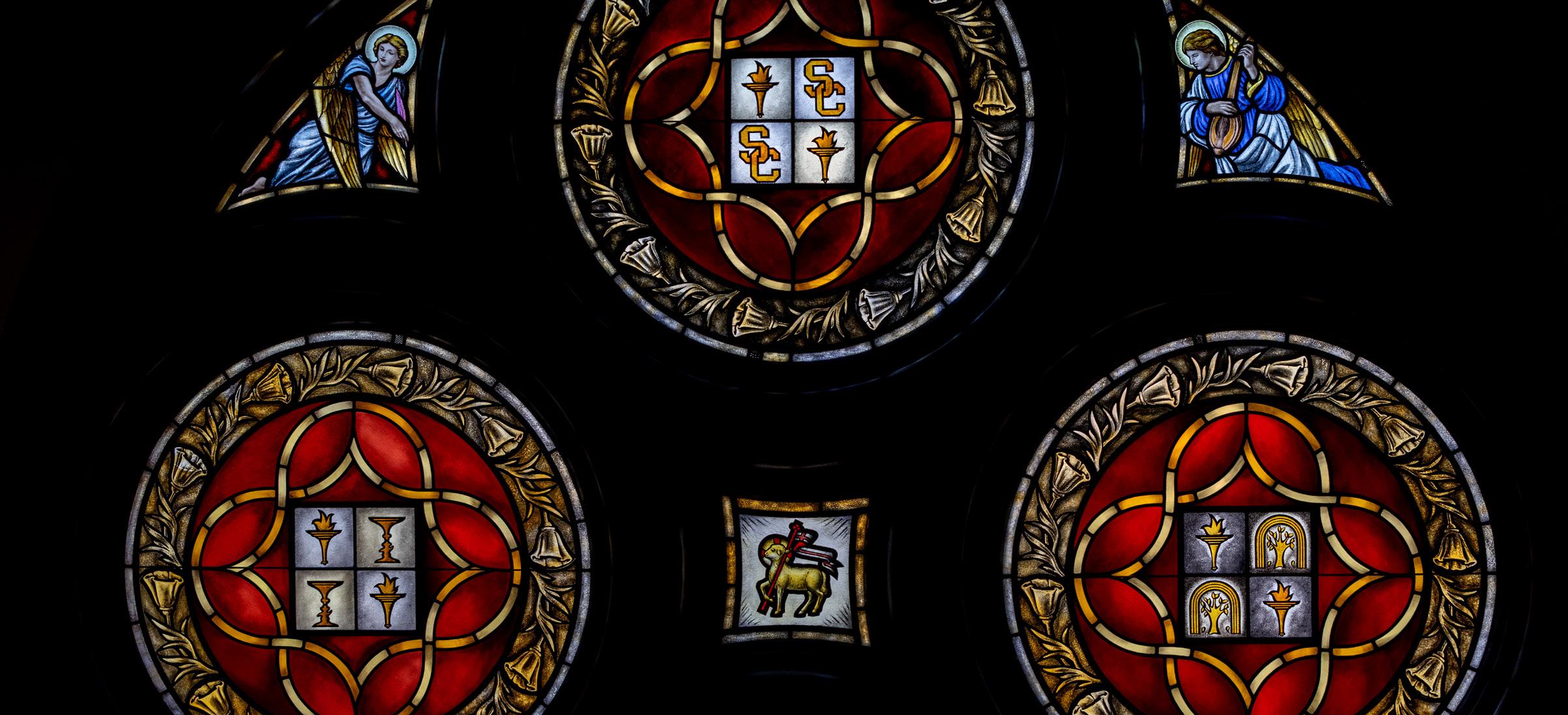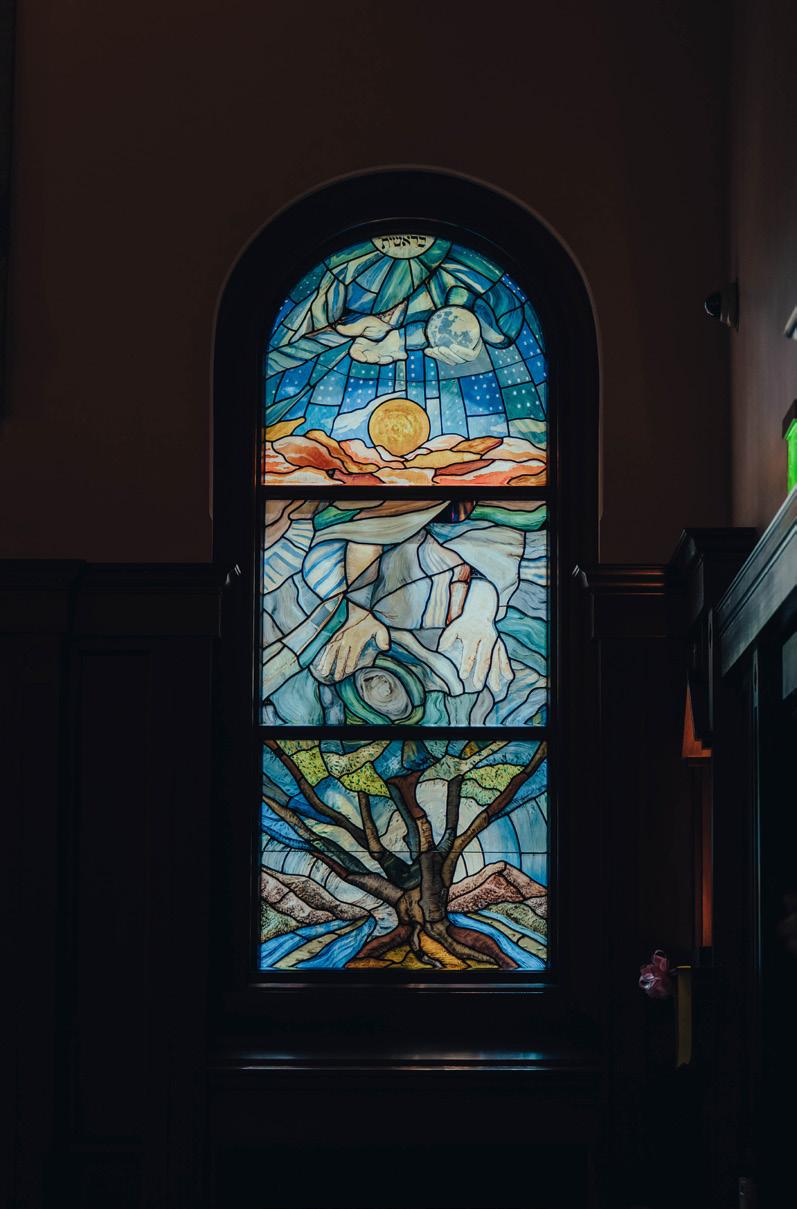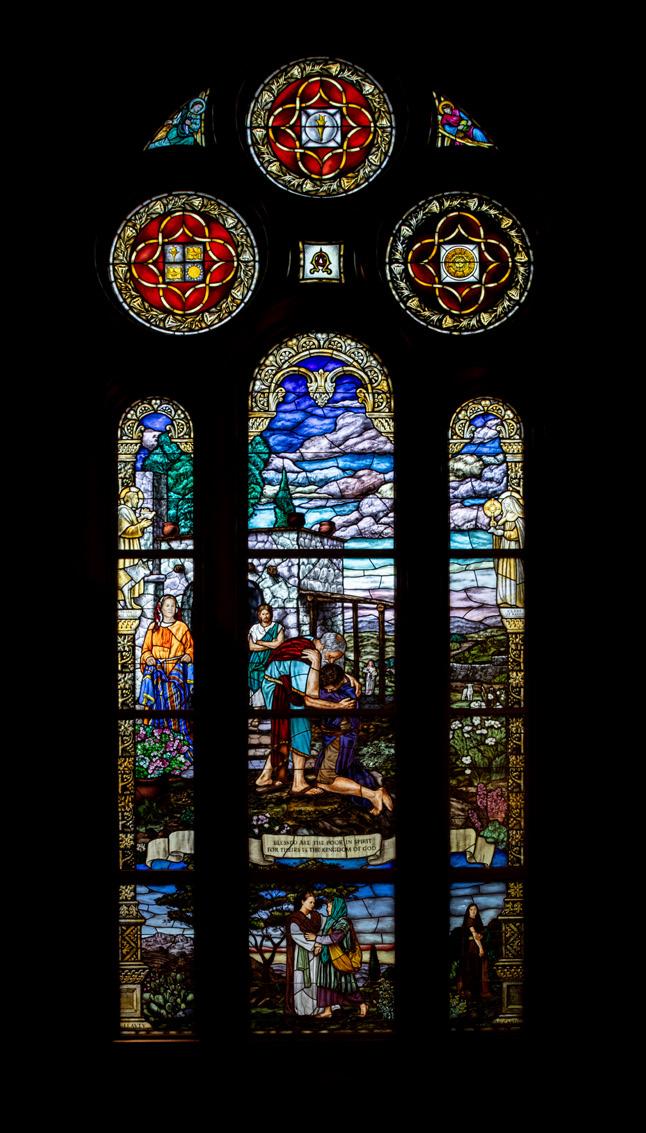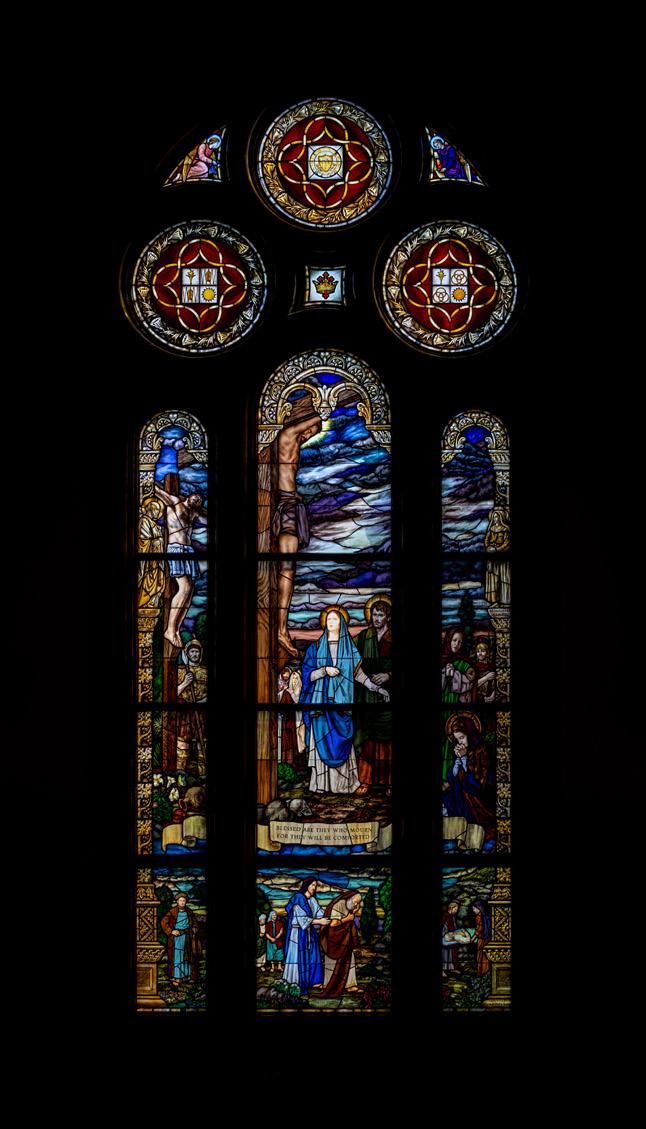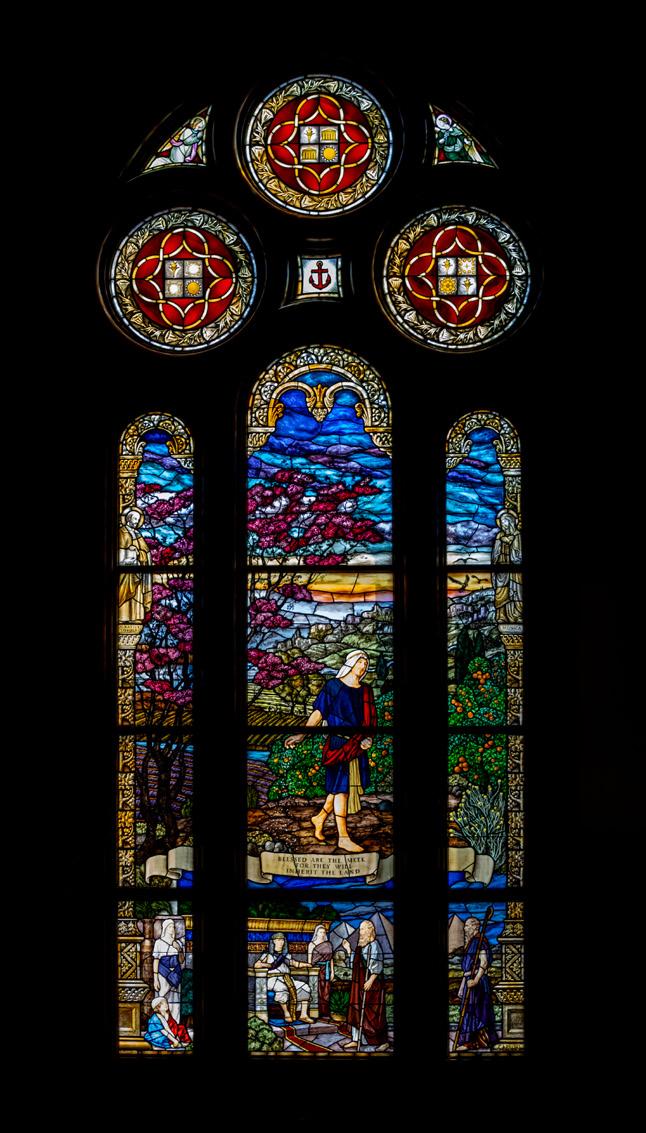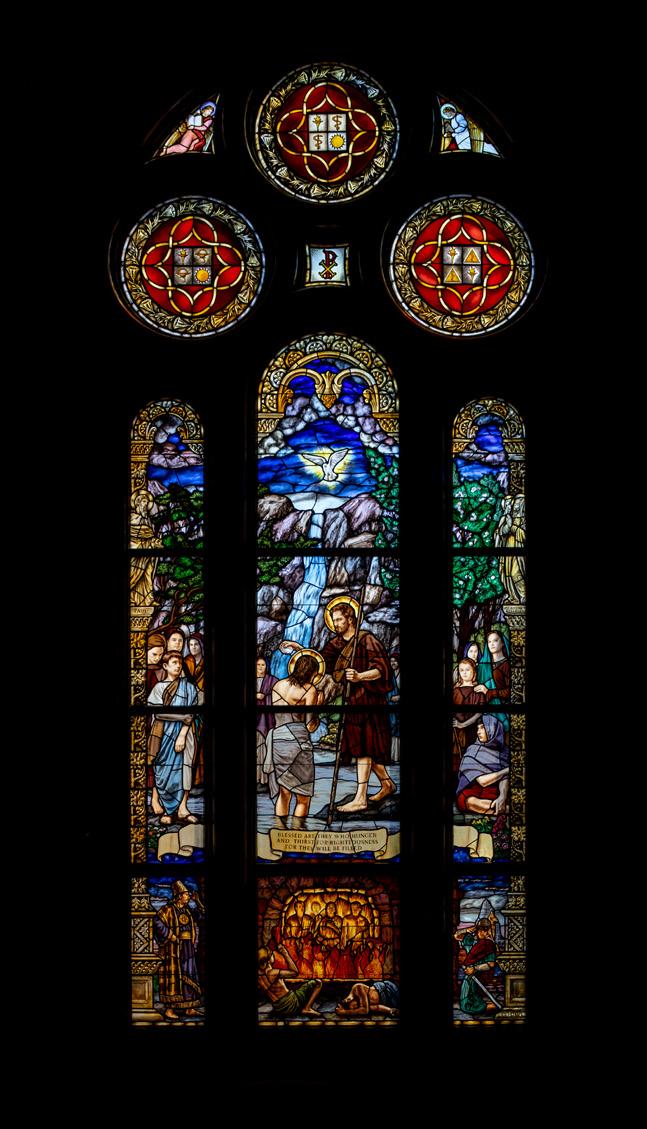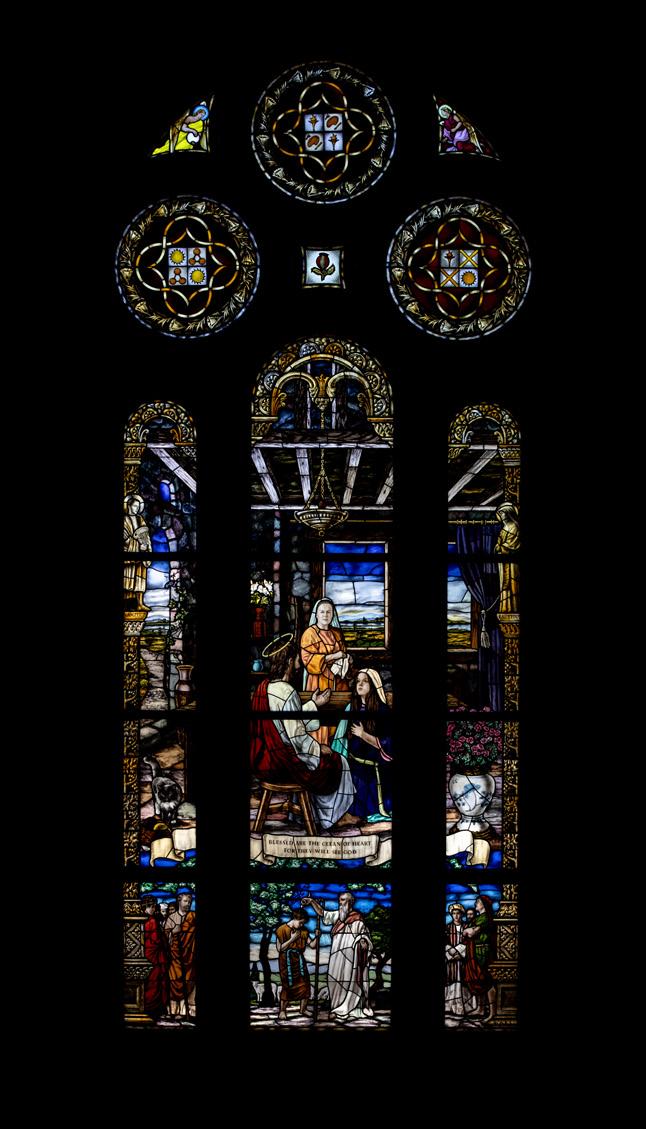Interior Architecture
a sacred masterpiece
As visitors step into the main Church through the vestibule, they are immediately immersed in an atmosphere of sacred beauty and architectural grandeur. Their eyes are drawn to the magnificent wooden arches that gracefully frame the space, leading their gaze upward to the breathtaking 50-foot pitched wood beam ceiling, a testament to masterful craftsmanship.
Sunlight filters through the strikingly beautiful stained-glass windows, which vividly depict the Eight Beatitudes, casting colorful patterns that dance across the interior. The richness of the African mahogany, meticulously incorporated throughout the sacred space, adds warmth and depth, enhancing the sense of reverence and awe.
Every detail, from the intricate carvings to the harmonious blend of light and structure, invites visitors to pause, reflect, and appreciate the artistry that elevates this holy place.
baptismal font & ambry
Near the entrance, the Baptismal Font, masterfully carved by Carnevale & Lohr, stands as a sacred reminder that through Baptism, we are reborn into the Body of Christ. The upper font is for infant baptisms while the lower font is for adult baptisms celebrated during the Easter Vigil. The water flowing from the top pool into the lower pool is meant to remind us of the living water of Baptism.
The black floor of the font represents our dying to sin and the cross, on the floor of the font, brings us out of that sin into Christ’s resurrection. Behind the baptismal font is the Ambry, donated by Dr’s Robert and Corina Ramirez, which holds the Sacred Chrism, Oil of the Sick, and Oil of Catechumen.
These holy oils are used in the sacraments that initiate and sustain our journey of faith. The proximity of the font to the Confessional highlights the deep connection between Baptism and the Sacrament of Reconciliation, both of which restore us to grace.
Moving toward the sanctuary, the Altar, the heart of the Church, stands as the sacred place where Christ’s Sacrifice is made present in the Holy Eucharist. The Ambo, to the left, serves as the pulpit from which the Word of God is proclaimed. The Presider’s Chair, to the right, signifies the authority of the priest as shepherd of the flock.
The onyx accents found in the Altar, Ambo, and Presider’s Chair remind us of Christ’s abiding presence in the priest, the Word, and the Eucharist.
the altar & ambo
Behind the Altar lies the Eucharistic Chapel, a place of silent adoration before the Blessed Sacrament. At its center stands a magnificent tabernacle, lovingly restored from a historic Church in Chicago.
Above, the golden domed Apse radiates divine light, while stained-glass windows depict nine Doctors of the Church, reminding us of the rich intellectual and spiritual heritage of our faith.
eucharistic chapel
Above the Baptismal Font and along the back wall hang breathtaking tapestries by renowned Catholic artist John Nava. These works depict the four Gospel writers—Matthew, Mark, Luke, and John—surrounded by sacred script recounting the Resurrection. tapestries
statues of mary & saint joseph
Flanking the sanctuary, hand-carved wooden statues of the Blessed Virgin Mary and Saint Joseph, crafted by Bartolozzi and Maioli, invite the faithful into deeper devotion. Mary, holding a bouquet, gestures toward her Son, always directing us to Christ.
Saint Joseph, depicted with an ox yoke, calls to mind Jesus’ words: “For my yoke is easy and my burden is light” (Matthew 11:30).
the monstrance
The monstrance is a sacred vessel used for Adoration of the Blessed Sacrament. Its sun-like design symbolizes Christ, the Light of the World, whose love radiates upon us all. In particular, the turquoise enameling around the glass opening helps us focus our gaze and prayerful attention upon our Eucharistic Lord who “remains with us always, until the end of the age” (Matthew 28:20).
This beautifully restored antique chalice serves as a tribute in honor of the life and legacy of our longtime sacristan, Lynda C. Coleman. Hallmarked by Benziger Bros., this gold-plated sterling silver chalice dates back to the early 20th century. Its shape and form capture a noble simplicity that’s fitting for the celebration of the Eucharist and the Precious Blood of our Lord.
chalice
The Marian Chapel was commissioned by an anonymous donor and painted by Margaret Lazzari, Professor Emerita, USC Roski School of Fine Arts, in 2017 and took six months to complete. The USC Caruso Catholic Center Liturgical Design Committee selected Margaret among five other finalists.
One of the earliest chapels dedicated to Mary dates back to the Council of Ephesus, when the title of Theotokos, God-bearer, for the Mother of Christ was selected. As the most influential intercessor among all of the saints, it is perfect to have a Marian Chapel within the Church of Our Savior, Jesus.
As you enter the doors of the Marian Chapel, we envision Our Lady of Mercy, with her outstretched arms embracing those who enter, to be painted on the prominent north-facing wall. Symbolically, we have selected Our Lady of Mercy for the theme of the Marian Chapel because it is God’s unconditional mercy that is at the core of our faith.
As students enter the Marian Chapel carrying their burdens, their anxieties and their doubts, we hope they leave knowing the healing, loving and gentle embrace of our Mother Mary. Our prayer is that Mary’s Fiat, her yes to God, becomes an inspiration and example for our students’ own spiritual Fiat.
marian chapel
the crucifix
Suspended above the Altar is a seven-foot bronze Crucifix, designed by Christopher Slatoff. This unique depiction captures the moment when Christ, in His final act of love, entrusts Mary as the Mother of the Church: “Woman, behold your son! Then He said to the disciple, ‘Behold, your mother!’” (John 19:26–27).
the rose window
The Rose Window, a stunning creation by Gayle Roski and crafted by Judson Studios, was generously donated by Charles B. “Chip” Caldwell ’66. Roski’s design presented a technical challenge that pushed Judson Studios to explore important new methods. The fluid yet complex floral patterns, rendered in watercolors, would have been nearly impossible to represent in traditional leaded glass. By 2017, when the window was finally realized, construction already had begun combining traditional glass painting with the fusing of different colors of glass in the kiln.
This new technique gave the ability to maintain the details of the flowers while capturing the aqueous quality of Roski’s brushstrokes. lndre McCraw, a talented painter from New York, adapted this technique in collaboration with the artist from a major project Judson Studios had been working on at the Church of the Resurrection in Kansas. This distinctive process, specially crafted by Gayle for the rose window, makes it a truly one-of-a-kind masterpiece.
The term “rose window” likely derives from the French roue (wheel), reflecting their circular, radiating designs, though the rose also carried symbolic weight as a reference to the Virgin Mary, often called the “Mystical Rose” in Catholic devotion. The window’s stained glass transforms natural light into vibrant hues, representing the Light of Christ illuminating the church and the soul.
stations of the cross
Along each side of the church, you will encounter the 14 Stations of the Cross, beautifully rendered as oil paintings by renowned artist Peter Adams. In preparation for this sacred series, Adams embarked on a pilgrimage to Jerusalem, immersing himself in the landscape and historical surroundings where these profound events took place.
His journey allowed him to study not only the geography but also the natural lighting and atmosphere at each traditional location of the Stations. This careful attention to detail is reflected in the way he has captured the changing daylight and shadows appropriate to each moment of Christ’s Passion, lending the artwork a vivid sense of realism and spiritual depth.
i. jesus is condemned to death
Gifted by Dorothy & Andy Mosich
ii. jesus receives the cross Gifted by Dianne Wilson
iii. jesus falls the first time Gifted by Gretchen & Jack Schumacher
iv. jesus meets his mother Gifted by the Helen Guho Family
v. simon of cyrene carries the cross Gifted by Gege & Stan Chambers
vi. veronica wipes jesus’ face Gifted by Dr. Thomas & Sally Edwards
vii. jesus falls the second time Gifted by Colleen & Patrick O’Brien
viii. jesus meets the daughters of jerusalem
Gifted by Christine Marie Ofiesh
ix. jesus falls the third time Gifted by Kath & John Trotter In Memory of Adeline & Hubert Normanlee and Michael Normanlee
x. jesus is stripped of his garments
Gifted by Linda & Burton Young
xi. jesus is nailed to the cross Gifted by Zelda Marzec
xii. jesus dies on the cross Gifted by the Matthew & Clare Faulkner Family
xiii. jesus’ body is removed from the cross
Gifted by Mr. & Mrs. Philip G. Boskovich
xiv. jesus is laid in the tomb
Gifted by Christine Marie Ofiesh
doctors of the church
This special panel, chosen by the Student Executive Board, honors various Doctors of the Church. Accompanying the depictions are scripture passages that also appear on the two large tapestries adorning the back wall of the church. These stained-glass windows not only illuminate the church with their radiant beauty but also weave together faith, history, and personal devotion, creating a sacred tapestry of light and meaning.
St. Thomas Aquinas - Gifted by Carnevale & Lohr
St. Thérèse of Lisieux - Gifted by the Deborah & Michael Felix Family
St. Robert Bellarmine - Gifted by Ann & O’Malley M. Miller
St. Gregory the Great - Gifted by William & Helen Close
St. Catherine of Siena - Gifted by Anita & Philip Finie
St. Peter Canisius - Gifted by Marjorie & Richard Stegemeier
St. Augustine of Hippo - Gifted by the J. Paul Harvey Jr., MD Family
St. Teresa of Ávila - Gifted by the Joe & Peggy Stemler Family
St. Albert the Great - Gifted by Marion Scharffenberger
the stained glass windows
One of the Church’s most captivating features is its eight large stainedglass windows, each illustrating one of Christ’s Beatitudes from Matthew 5. The lower portion of each window depicts an Old Testament scene that foreshadows its corresponding Beatitude, emphasizing the unity of Sacred Scripture.
Each window also includes a male and female saint who lived out that Beatitude, inspiring us to pursue holiness. The windows are crowned with three round emblems, honoring the seal of every USC college, with a shamrock motif in remembrance of Governor John Downey, an Irish Catholic and one of USC’s cofounders.
At the pinnacle of each window, angels soar toward heaven, reminding us of our final destiny in eternal communion with God. The windows were crafted by Judson Studios, whose founder was the first dean of USC’s fine arts school.
In 2012, Ruth Weisberg, the former dean of the USC Roski School of Art and Design, designed and painted the Creation window, one of two leaded windows with Old Testament themes that flanked the doors of the main entry.
The second window was commissioned in 2015 and portrayed passages from the book of Ezekiel.
window 1
Blessed Are the Poor in Spirit, for Theirs Is the Kingdom of God
Dorothy Leavey’s portrait is painted as the face of the woman carrying the robe in the New Testament window. Father Lawrence Jenco, a Servite priest who was held captive in Beirut in 1985, is depicted as the Father of the Prodigal Son.
Also depicted is the mother of David Judson, whose family ties to USC include his great-grandfather, a former dean of USC’s fine arts school. The wild sunflower in the corner symbolizes loyalty.
window ii
Blessed Are Those Who Mourn, for They Will Be Comforted
Depicting the Crucifixion, Christ is placed at the center, with the “bad thief” on His left and the community— represented as the “good thief”—on His right. A butterfly, a symbol of resurrection, is included within the scene.
Kathryn Sample, deeply devoted to the Virgin Mary, carefully selected the face of Mary, cycling through six different depictions before settling on the final version. There is a portrait of the mother of Mrs. Sample shown below the foot of Christ, as a distant onlooker.
window iii
Blessed Are the Meek, for They Will Inherit the Land
Known as the Sower Window, this design is filled with imagery of God’s abundance and generosity. Rick Caruso’s children are subtly incorporated into the background, working in the fields just above the sower’s elbow.
In the Exodus scene, a reference to Rick’s famous “Grove” property can be found in the throne’s design. A hidden detail includes Rick’s birthdate—can you find it?
window iv
Blessed Are They Who Hunger and Thirst for Righteousness, For They will be Filled
This was the last window created, and Sue Femino’s Mother, Daughter, Two sons, and 3 Grandchildren are models for the onlookers. In the background is a waterfall. The local reference used was Sturtevant Falls in the San Gabriel Mountains.
window v
Blessed Are the Merciful for They Will be Shown Mercy
As the first window completed, this design stands out as the only one not created using computer technology. The deer and hawk featured are the only animals depicted that are native to Southern California.
The Finn family members appear within the scene. Madeleine Marin- Finn is depicted as the woman on the bottom right panel with the young boy. Father Lawrence Seyer, former Pastor, requested this window be completed first so that Mrs. Finn, who was ill at the time, could see it. She was able to witness its completion just three days before she passed away.
window vi
Blessed are the Clean of Heart for They will See God
This window honors the Roski family, featuring their children and grandchildren within the scene. The two women are modeled after Gayle Roski’s daughter and granddaughter, the cat on the left is Gayle’s “Tuxedo” (playing with a basket of yarn, in the USC cardinal and gold).
There is a vase with three calla lilies, symbolizing the Resurrection of Jesus. (The vase is shaped like the Stanley Cup in reference to the LA Kings victory in 2012.) The Roski grandsons are the models for three of the eight sons of Jesse.
window vii
Blessed Are the Peacemakers for They Will Be Called Children of God
Rod Dedeaux is depicted as the Shepherd on the right side of the window. The red sunset honors his love of beautiful skies, and a silhouette of a tiger with a baseball—near the wolf’s face—nods to his habit of calling everyone “Tiger.”
The red roses honor Helen Dedeaux. A bristlecone pine, the oldest living organism and native to California, stands tall on the right. Two distant sheep lead the eye to Bethlehem, glowing beneath the star. Above, a host of angels bursts through colorful clouds, descending from the heavens.
window viii
Blessed Are They Who Are Persecuted for the Sake of Righteousness, for Theirs Is the Kingdom of God
Saint Stephen stands at the center of this window, surrounded by members of the Boskovich family, integrating them into this powerful biblical narrative. There is a farm in the center distance in tribute to the Boskovich family business.
Also included are portraits of Joe Boskovich’s parents as well as his granddaughter. The Croatian coat of arms is shown on the stole of St. Stephen, and the symbol for eating disorder awareness carved into a rock on the left.
Thank you for your generous support of our donors and benefactors in building Our Savior Parish and USC Caruso Catholic Center. Your contributions have created a sacred space where lives are transformed, faith is deepened, and community is truly alive. This church stands as a testament to your faith, vision, and commitment.
Bell Tower
Eucharistic Chapel
Altar
Reredos
Baptismal Font
Bill Hannon Foundation
Elizabeth A. and Robert W. Plumleigh
Regina and Charles Leimbach
William R. and Virginia Hayden Foundation
William H. Hannon Foundation
Bell Tower Cross Rolf Rohn
Crucifix
Tympanum
Mary & Joseph Statues
Tabernacle
Tabernacle Altar
Presider’s Chair
Processional Cross
Nativity Set
Grand Piano
Holy Water Stoop
Paschal Candle
Vestments
Grand Entry Doors
Heather and Bud Daily
Joanne and Marcel George
Carolyn and John Menne
Elizabeth A. and Robert W. Plumleigh
Robert and Karen Hoehn Family
Margaret and John Given and Family
Pamela and James Abbott
Saranne Di Rocco
Adams Mastrovich Family Foundation
In Honor Of Stella Marich
Patrick & Julie Pascal
Randy & Ellen Beatty, Dr. Thomas Ahern
Dan Murphy Foundation
Altar candles (4) John Wavell
Chalice
Monstrance
Lynda Coleman
Tom Condon
©2025 our savior parish & usc caruso catholic center
produced and published by our savior parish & usc caruso catholic center los angeles, ca
editor & designer ricky cruz
photography zach fiedler
jazmin de guzman
copywriting fr. matthew wheeler ’10 jamie cappetta



